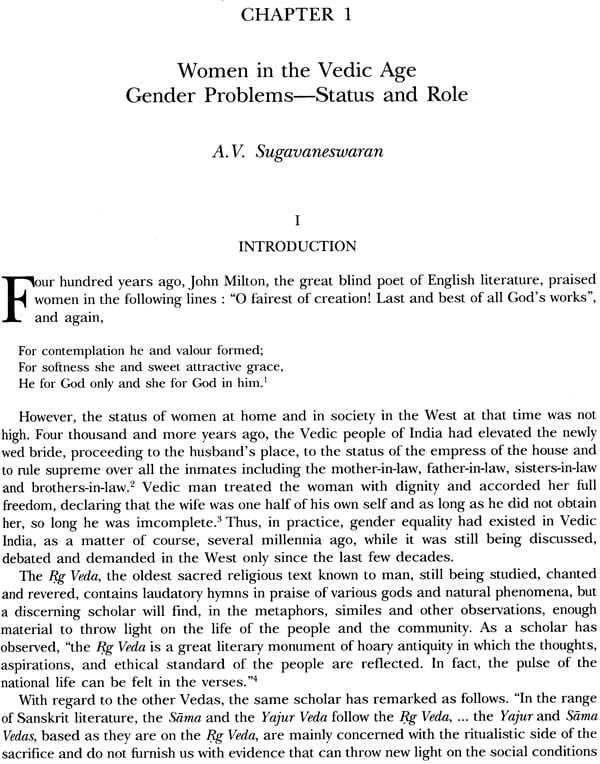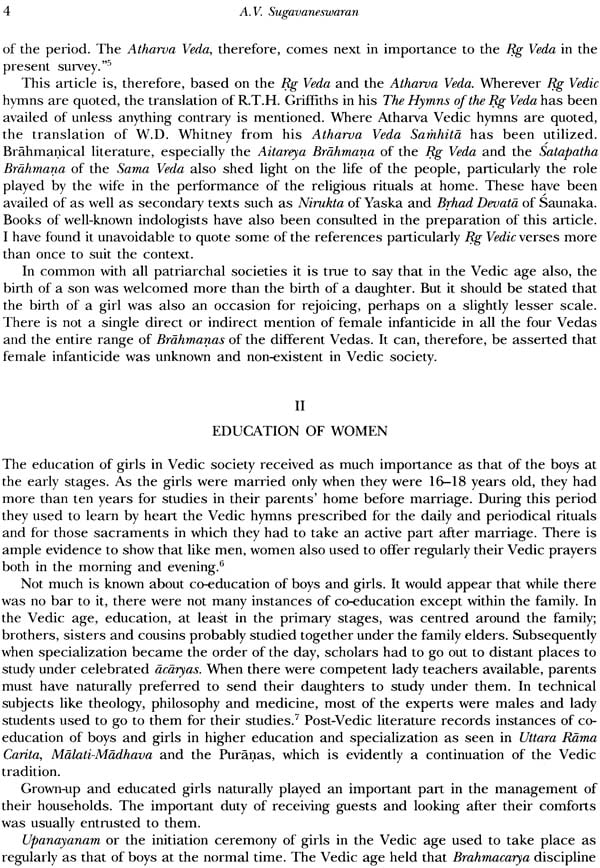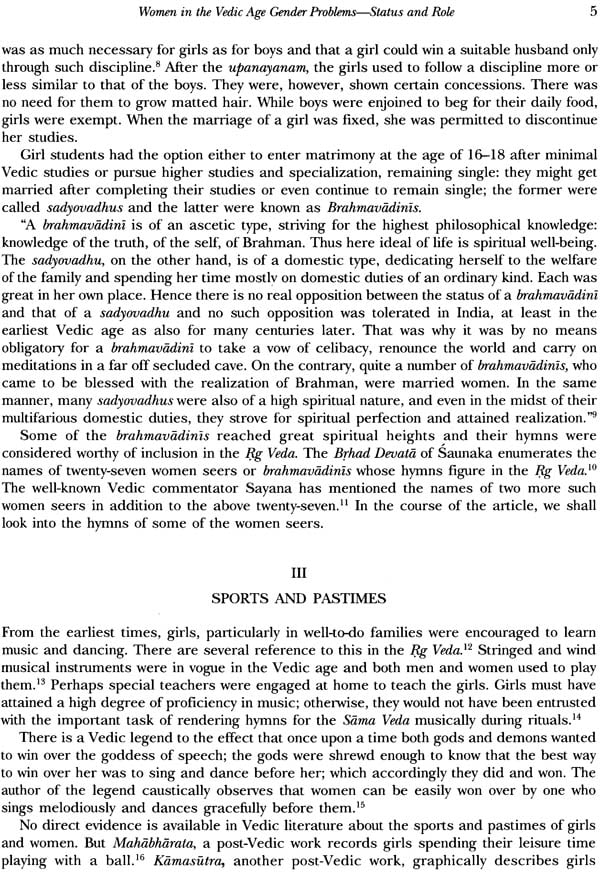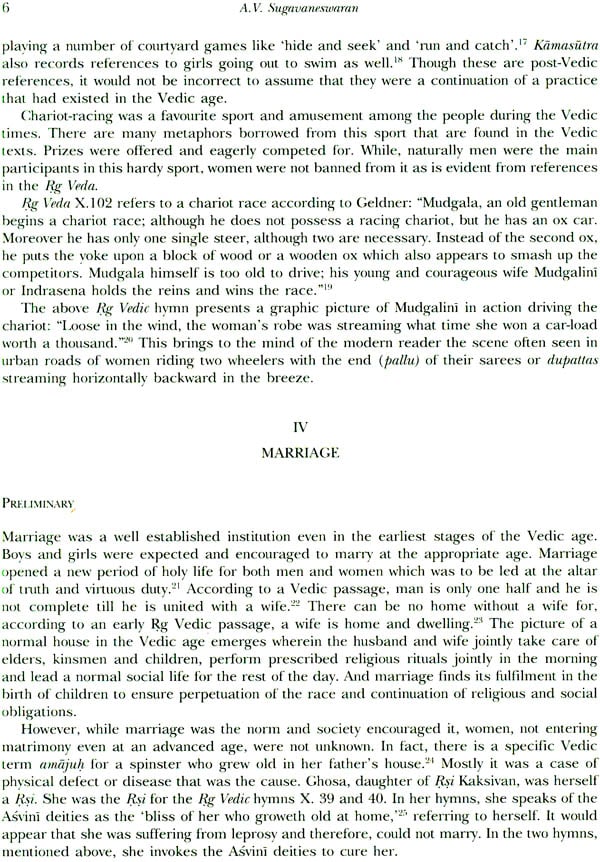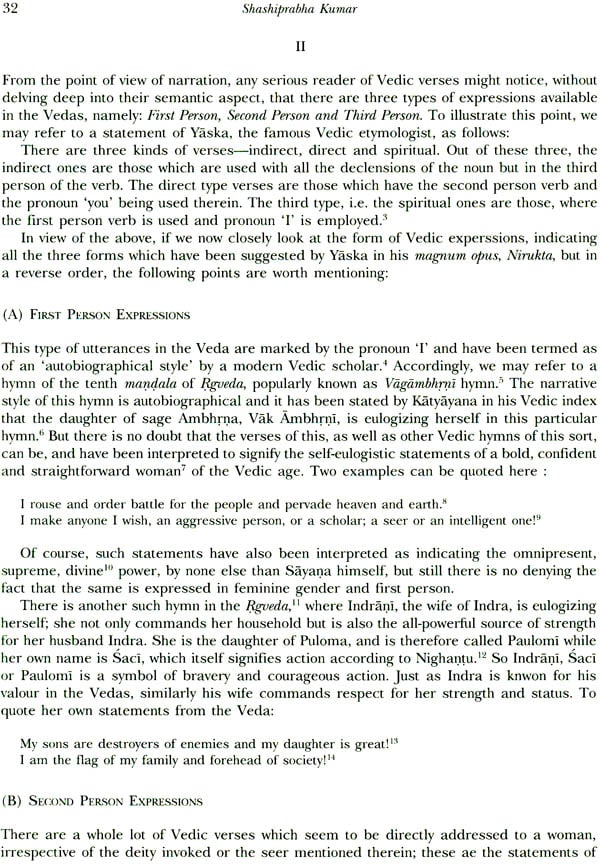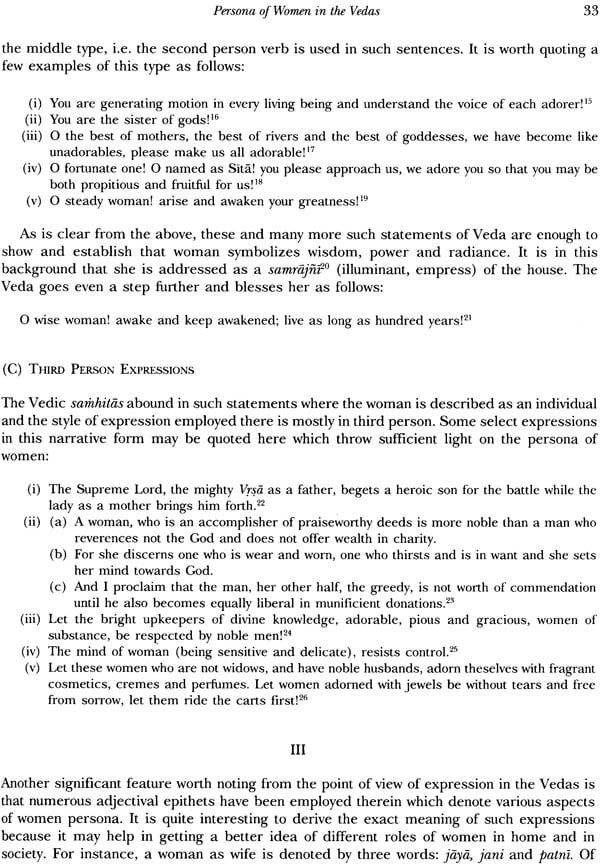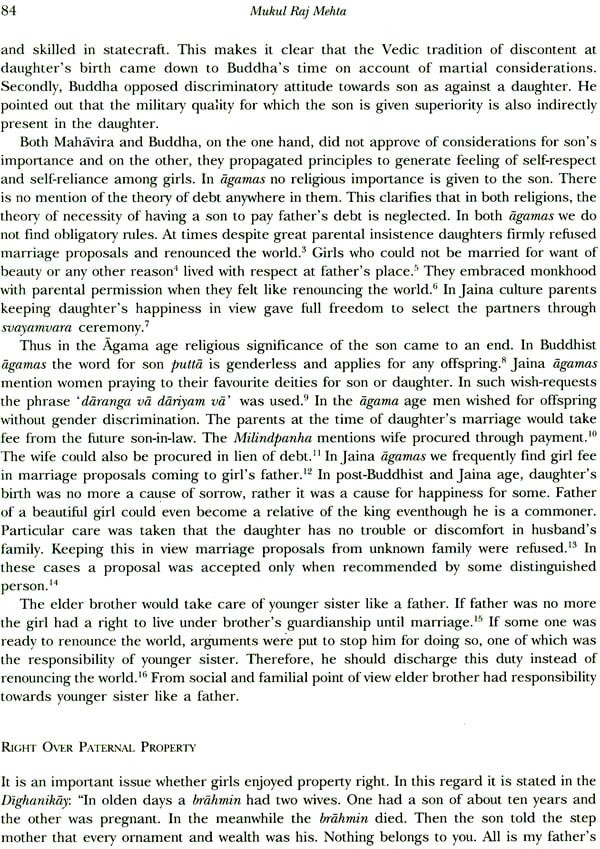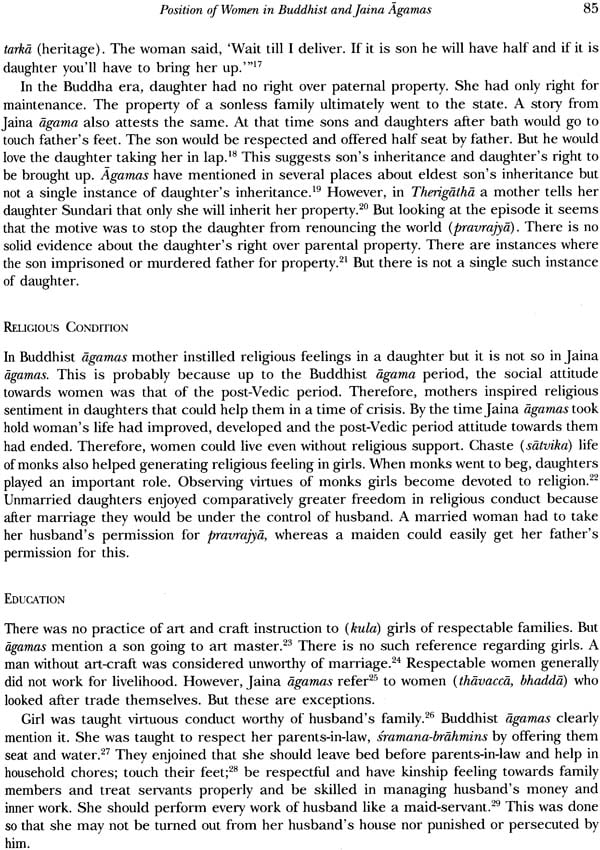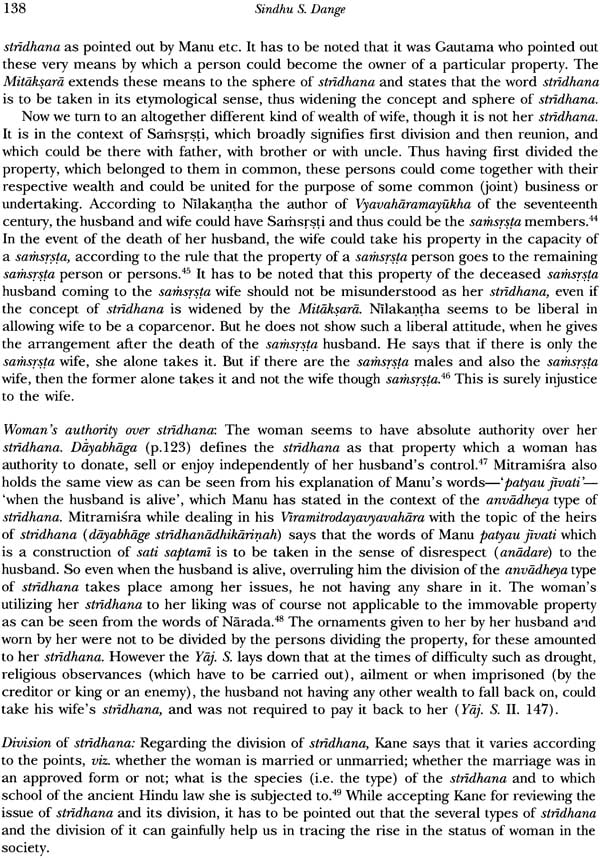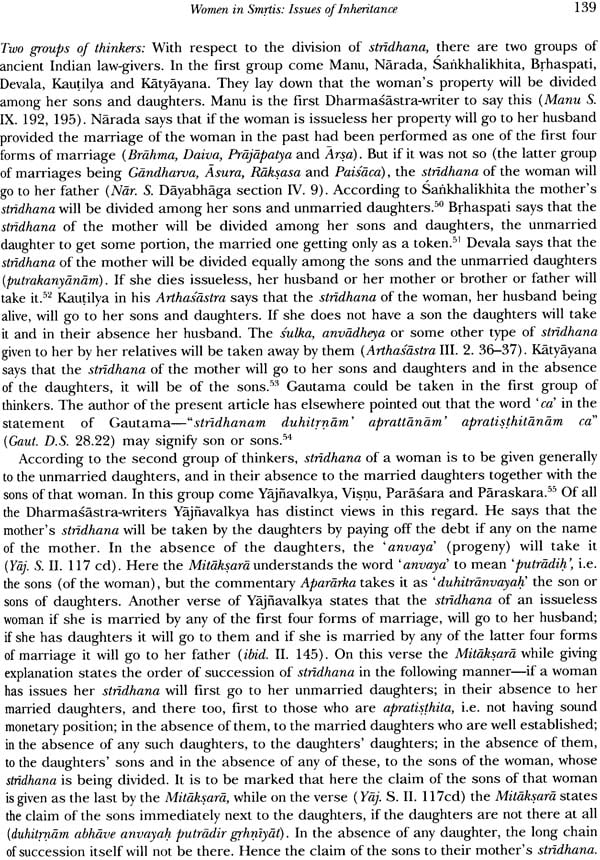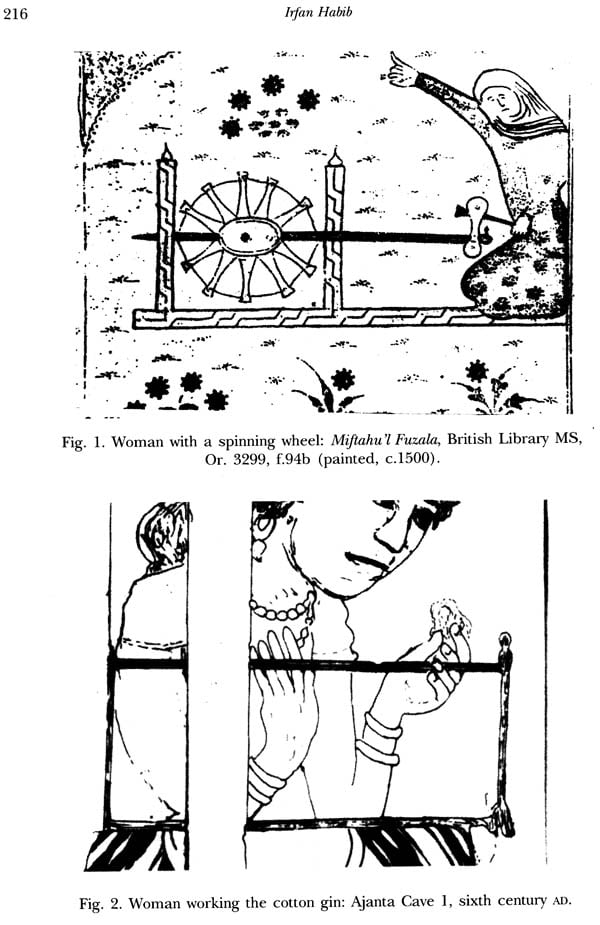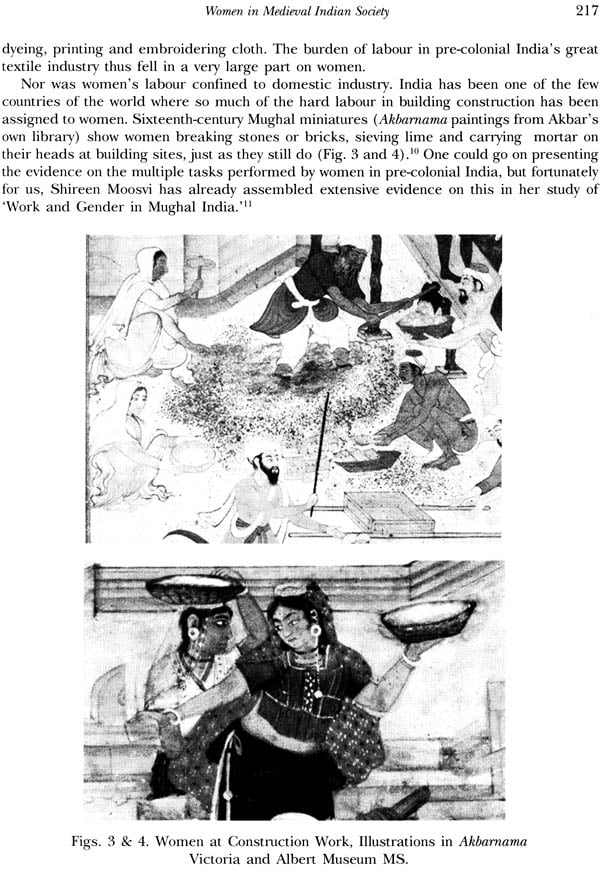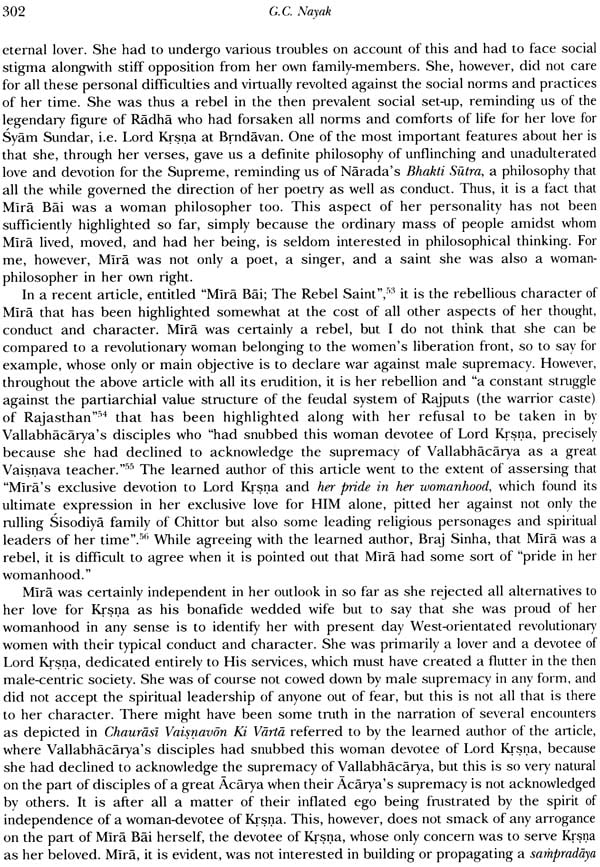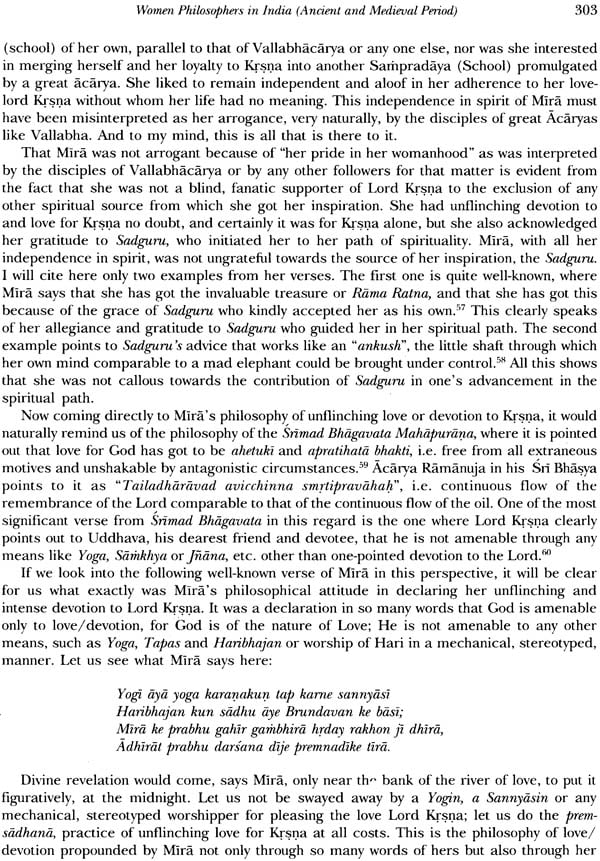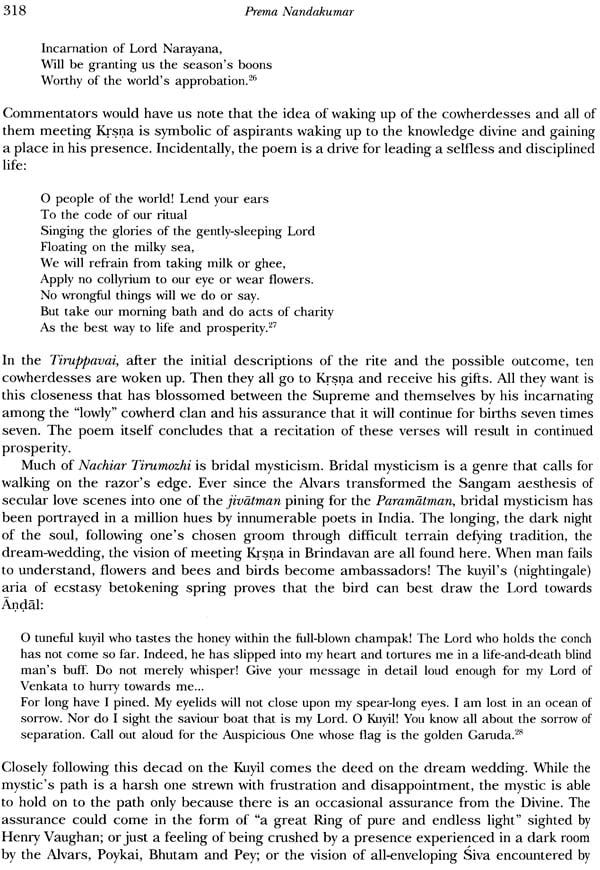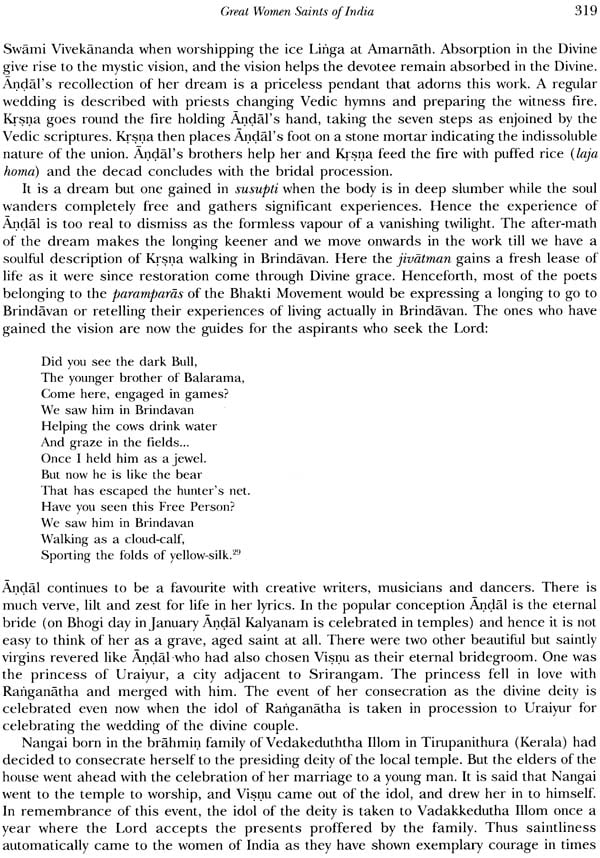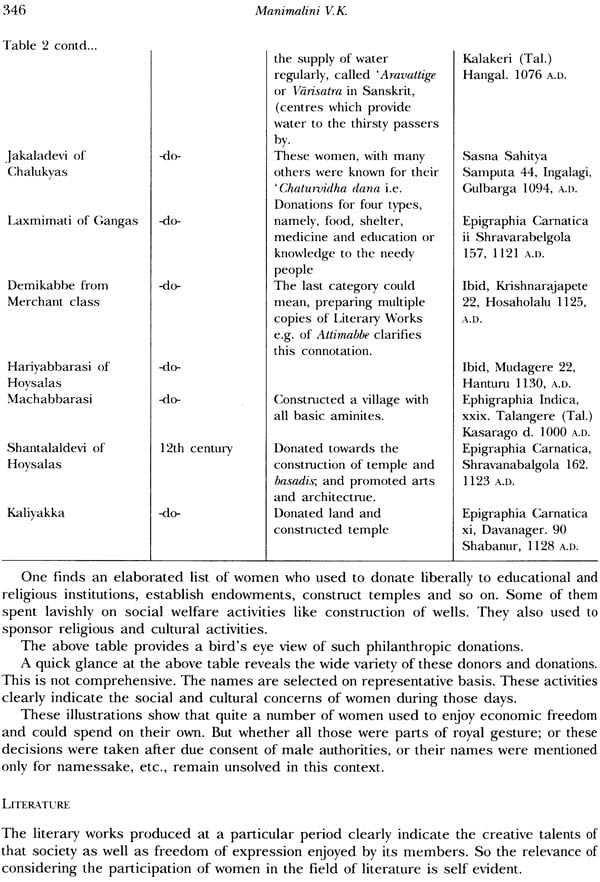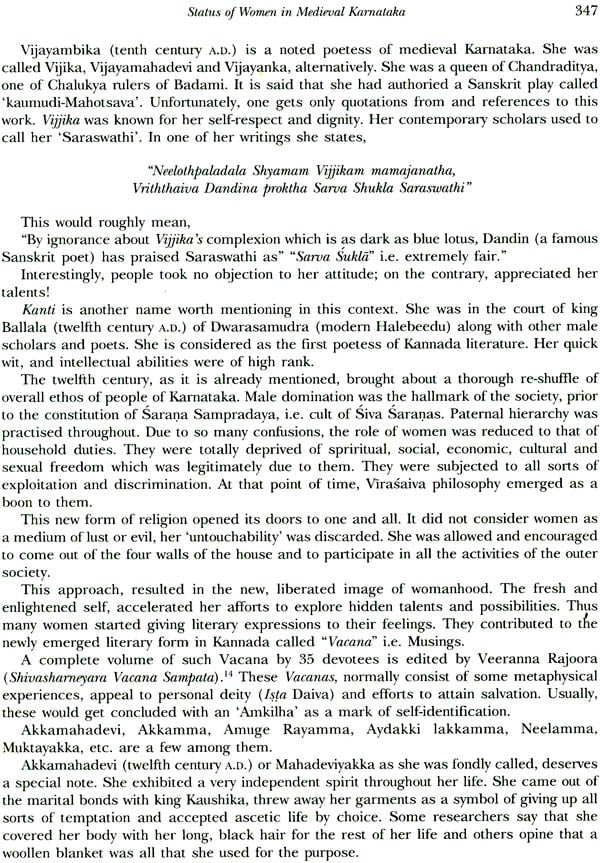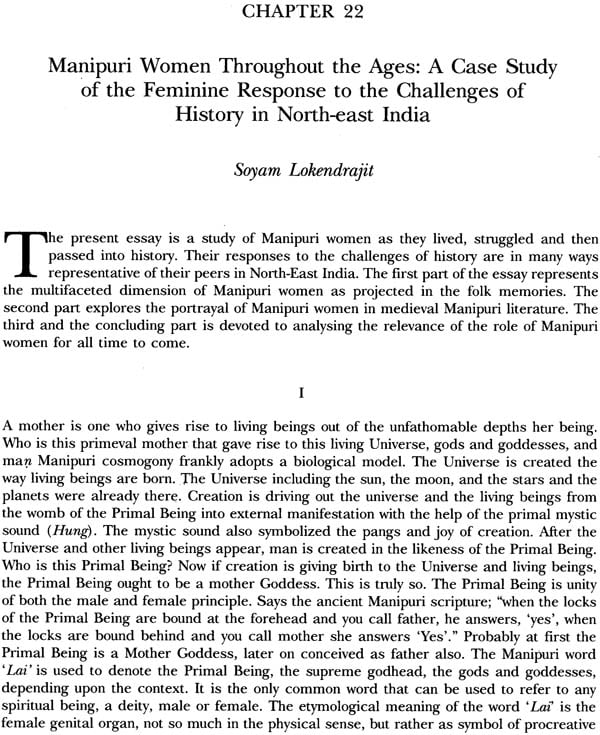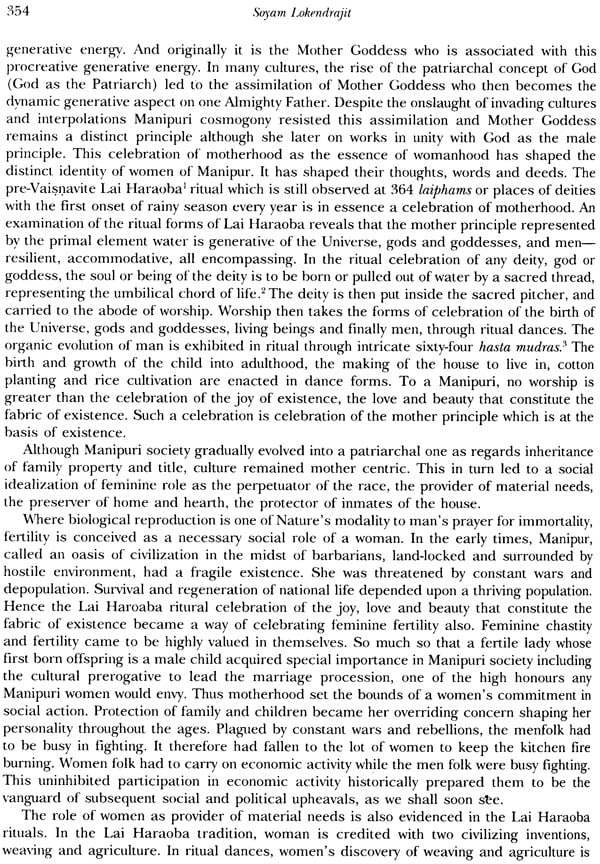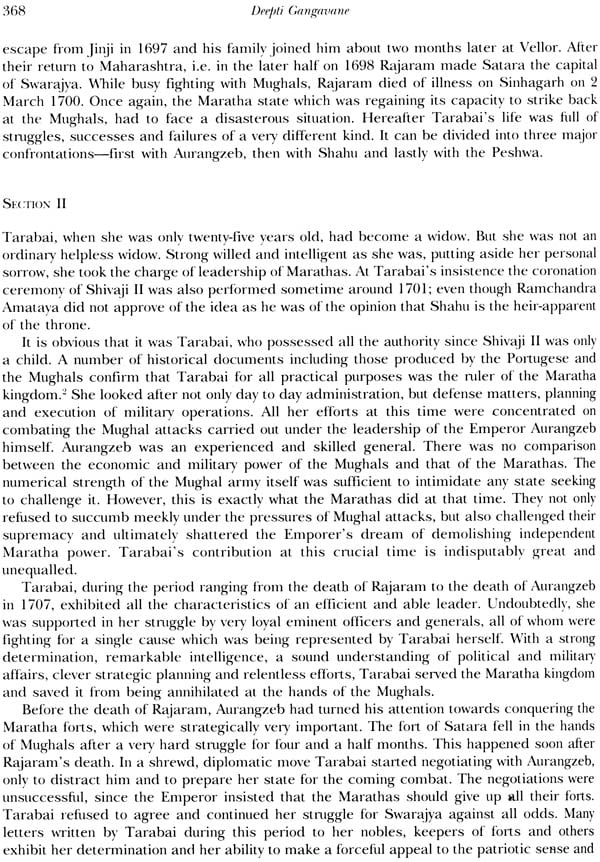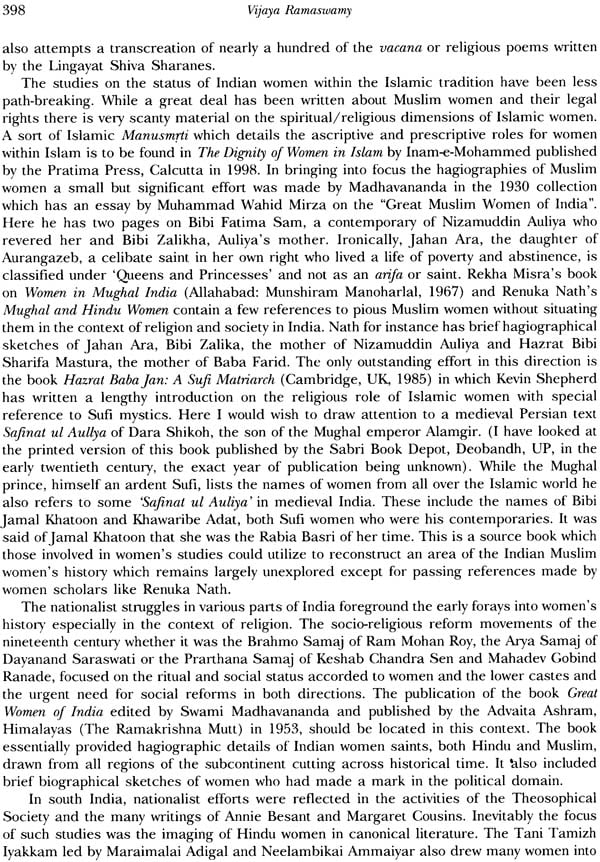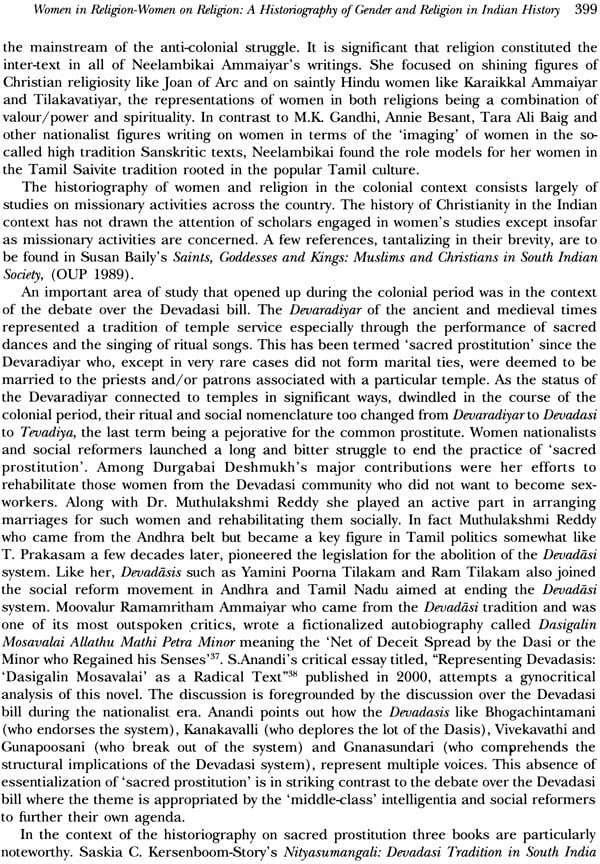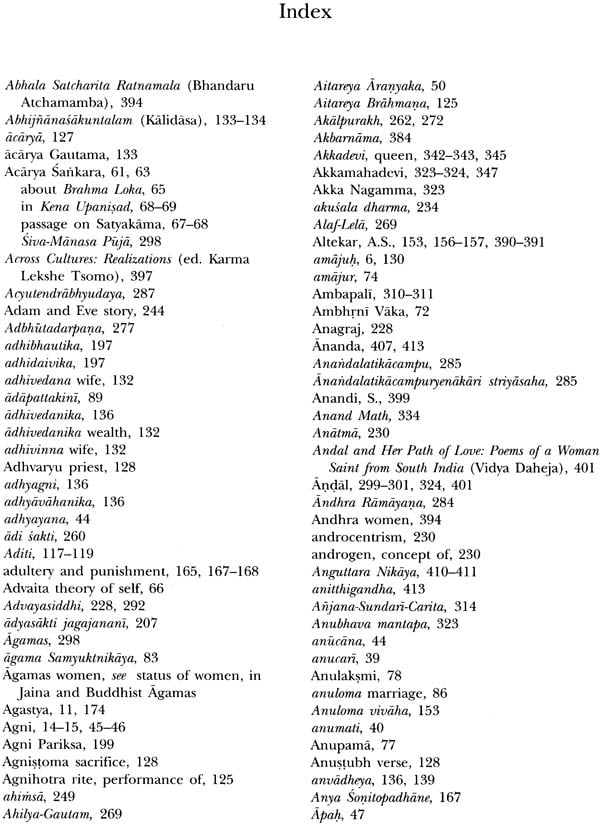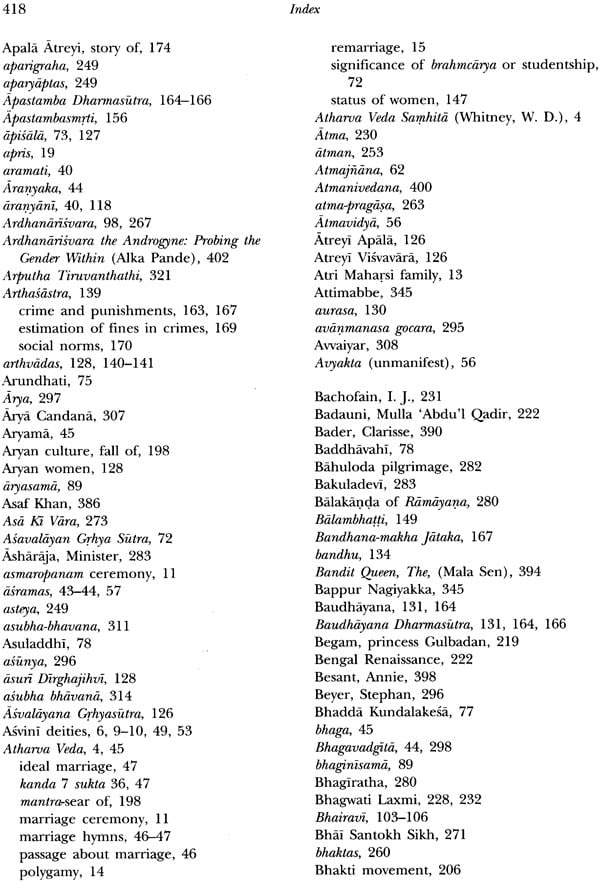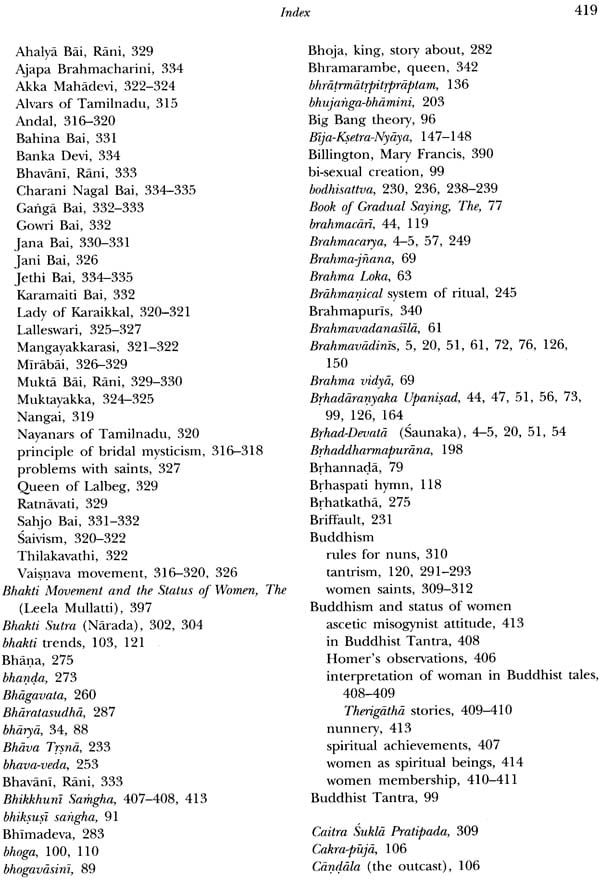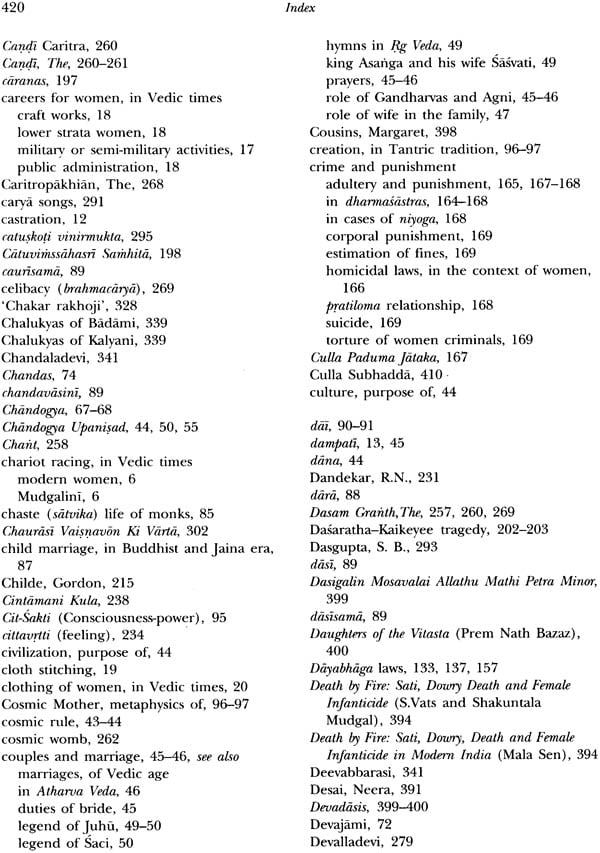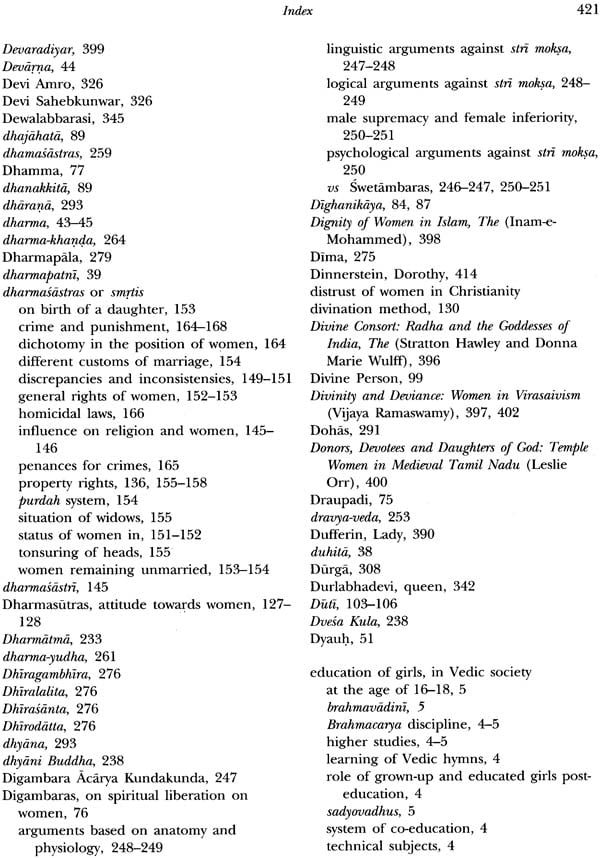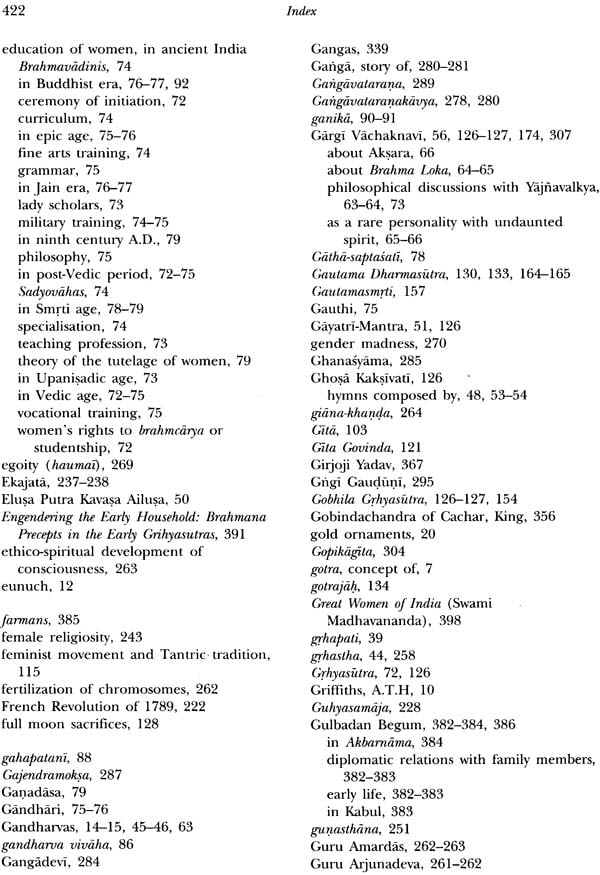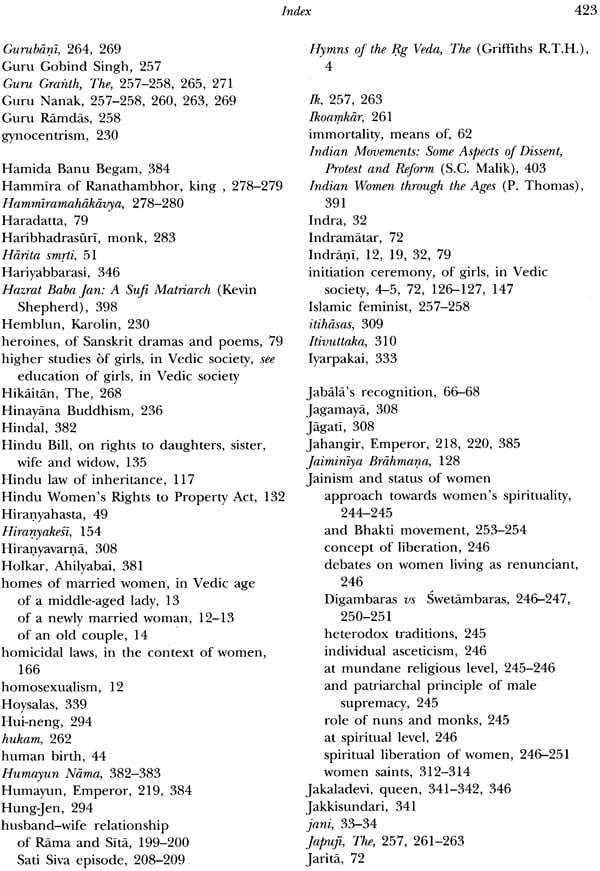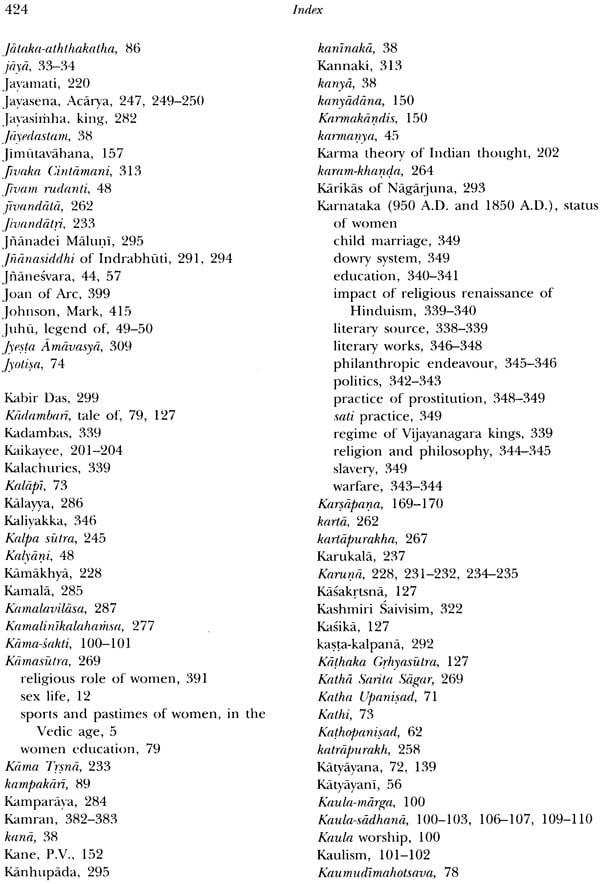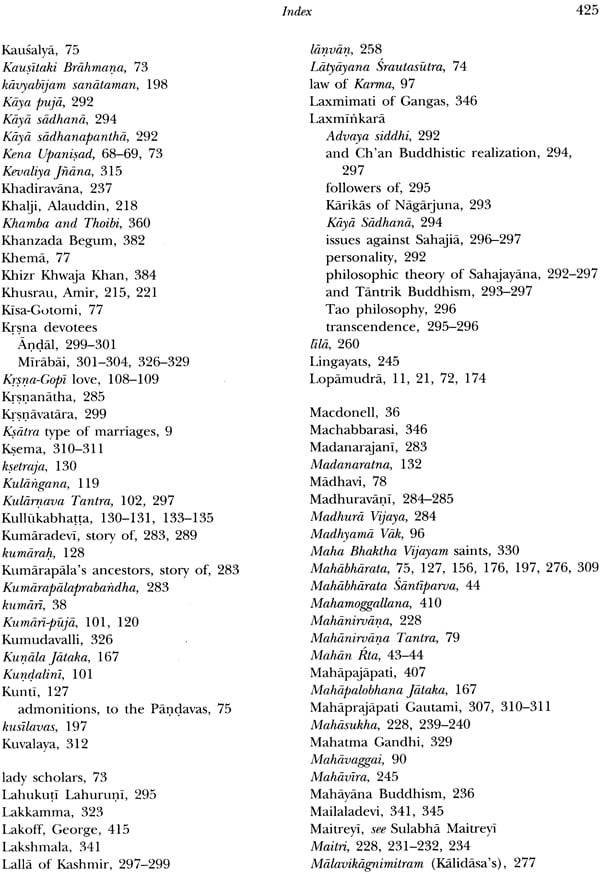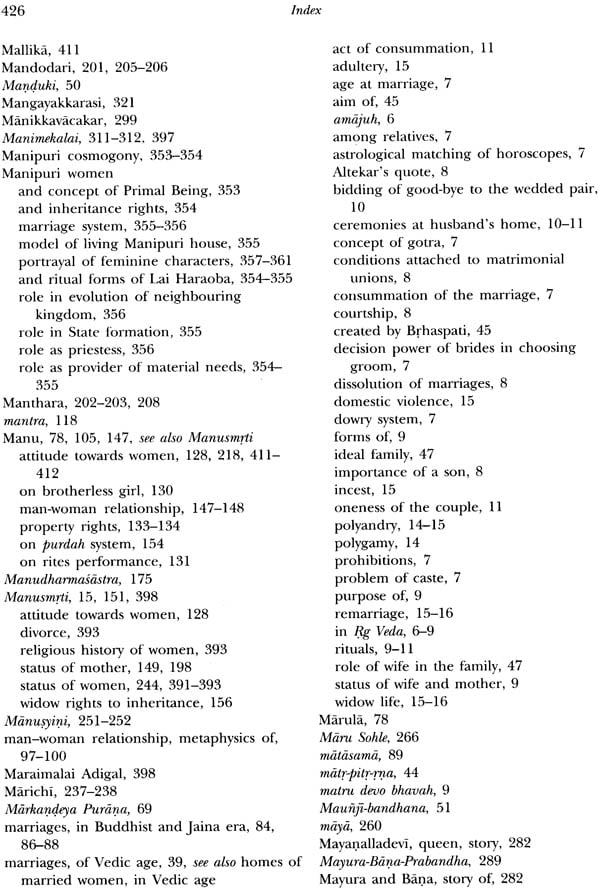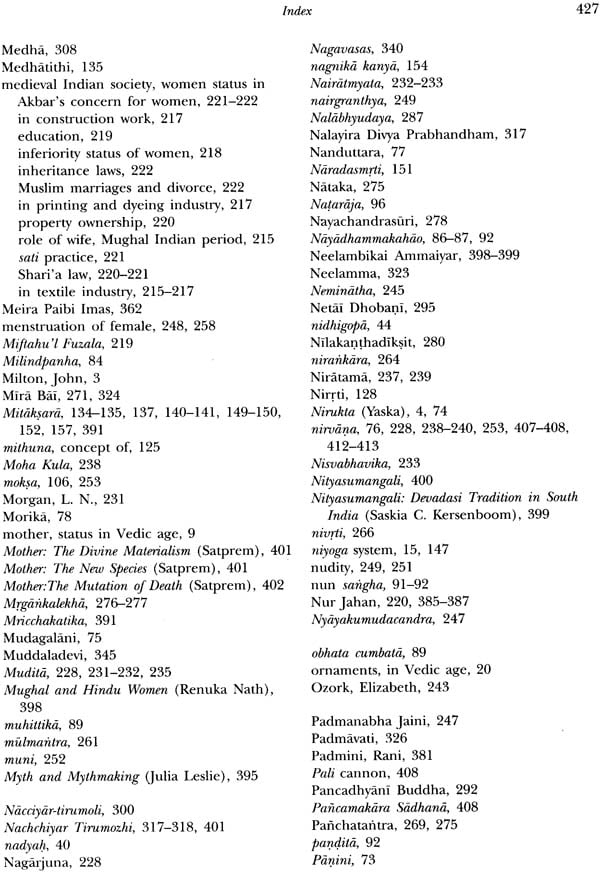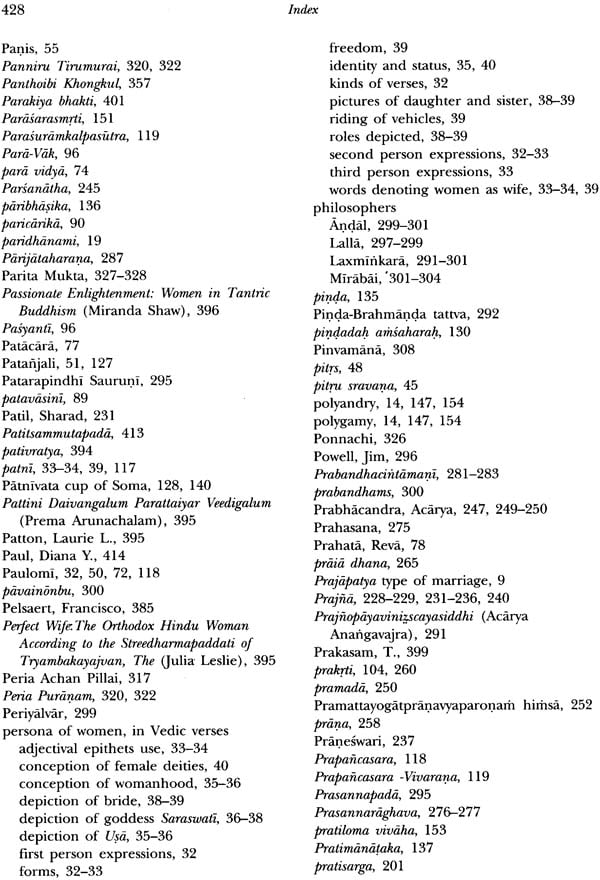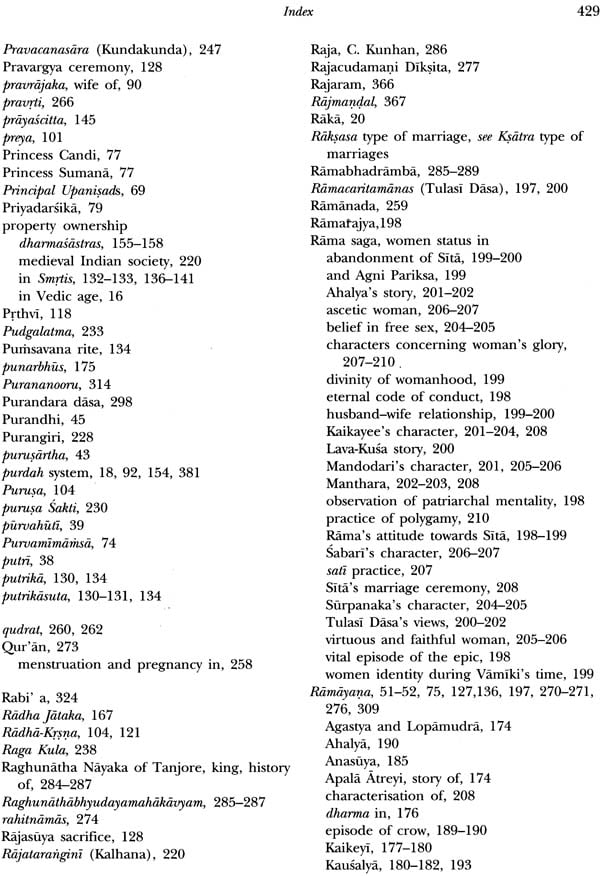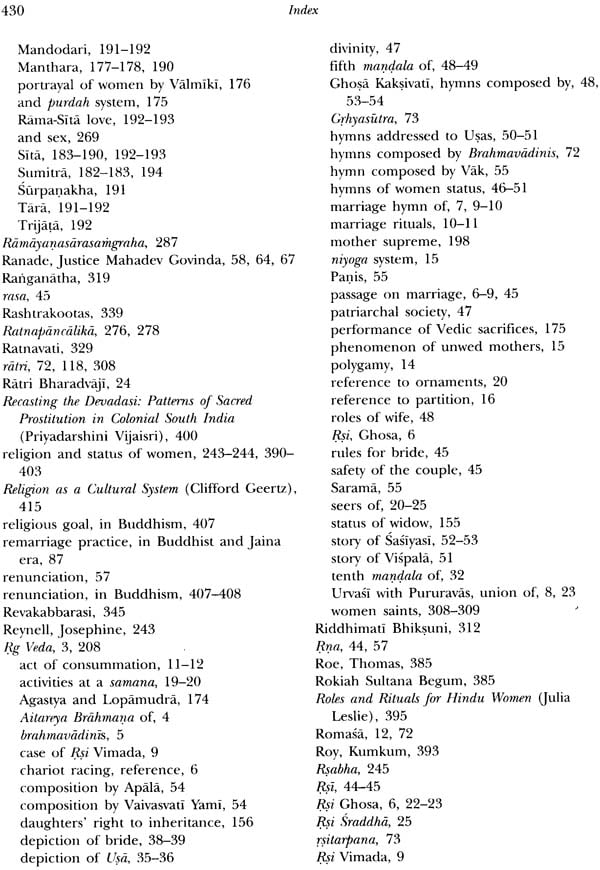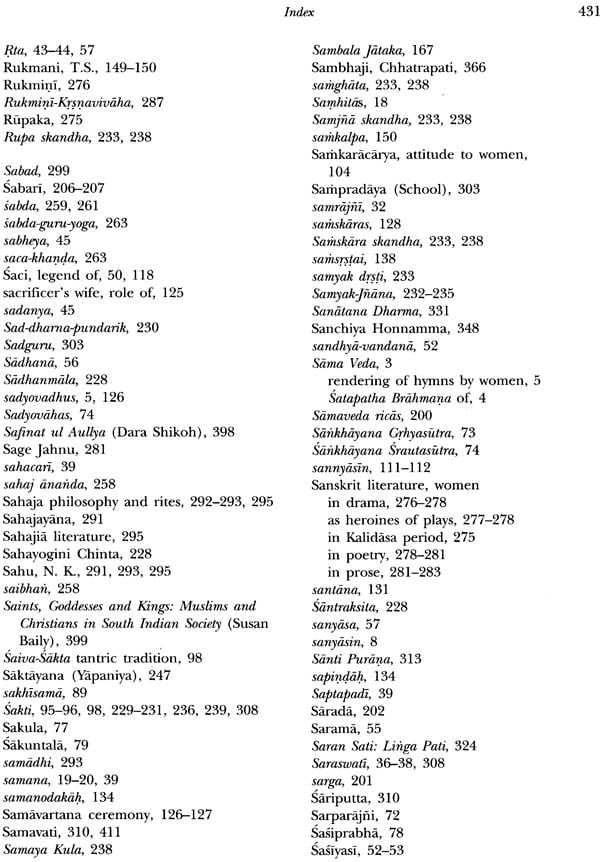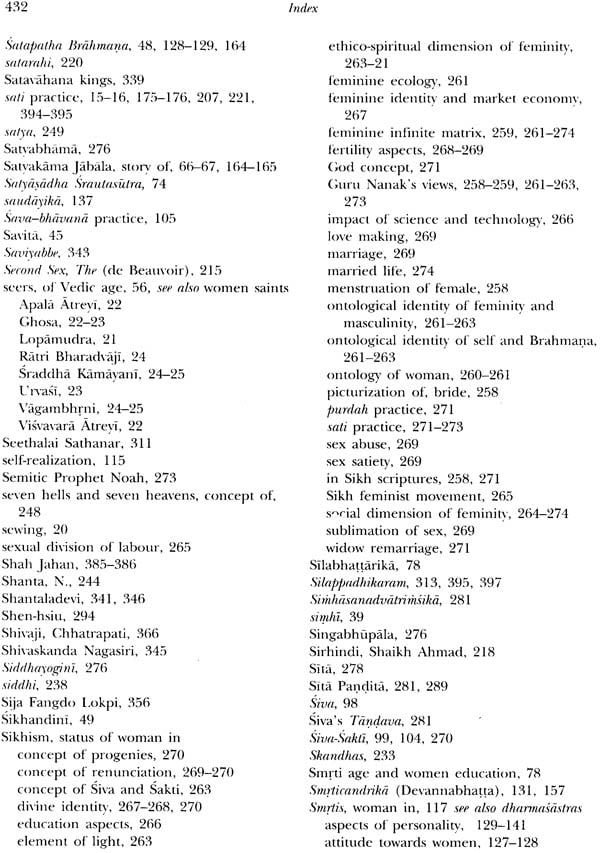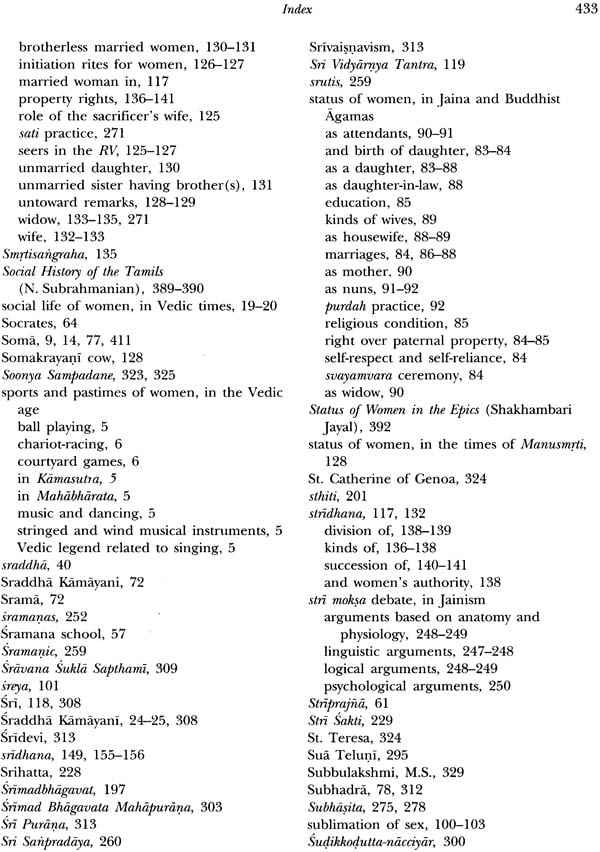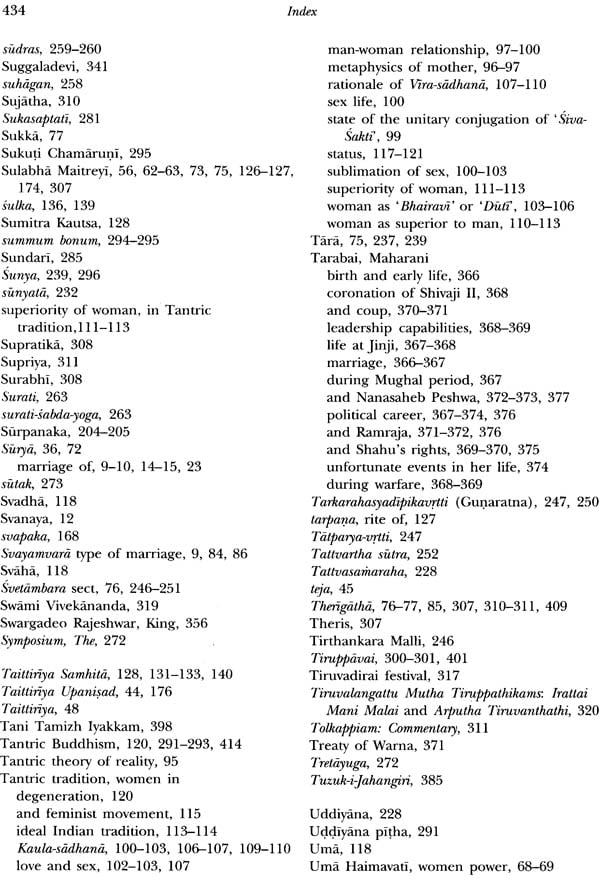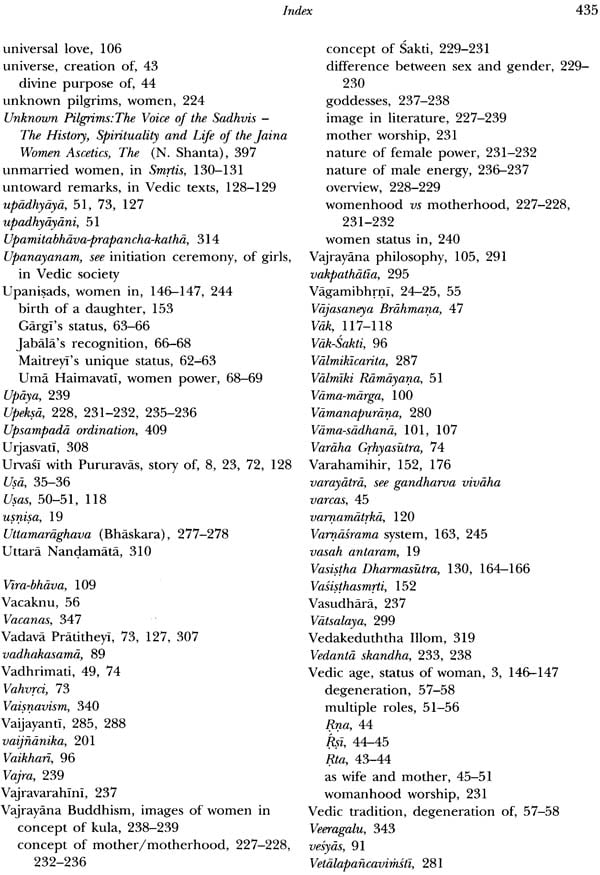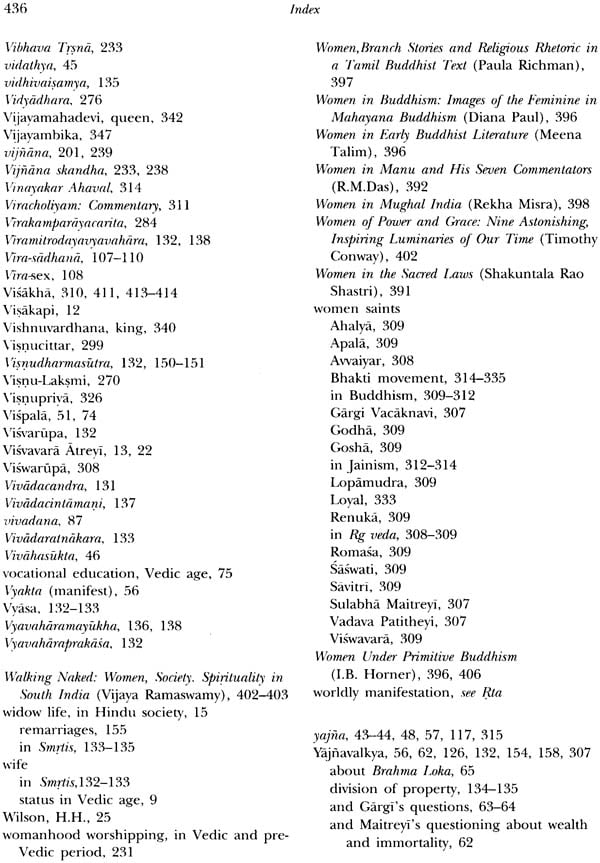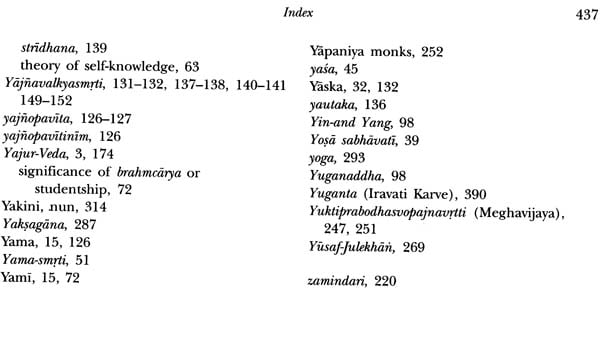
Women in Ancient and Medieval India
Book Specification
| Item Code: | IDL166 |
| Author: | D.P. Chattopadhyaya |
| Publisher: | PROJECT OF HISTORY OF INDIAN SCIENCE, PHILOSOPHY AND CULTURE |
| Edition: | 2009 |
| ISBN: | 8187586354 |
| Pages: | 478 |
| Cover: | Hardcover |
| Other Details | 11.0” X 8.5” |
| Weight | 1.68 kg |
Book Description
From the Jacket
The Volume is a part in the series of the Project (PHISPC), the aim of which is to discover the main aspects of Indian culture and civilization in the given socio-historical matrix narrated by Indian historians and historiographers. Every age rewrites its own history with fresh reassertion of having discovered newer truths. The most important characteristic of being human is to be self-aware and to deepen the knowledge of this self-consciousness in all dimensions-historical, cultural and ethnic. This is what this Volume is trying to re-discover, i.e. the ideational past in the sense of self-consciousness with respect to the womanhood of India.
The Volume delineates the different aspects and perspectives of the concept of woman in the traditional past and the place accorded in society by different schools of thought both pro-Vedic and anti-Vedic. Buddhism, Jainism and Islam have been given due importance. The unifying character as well as the conflictual and assimilative aspects of these schools of philosophy has been kept in mind while discussing the position of women in Indian tradition.
If human essence is understood to be universal then some significant questions arise: What would be the status of women? Has Indian tradition treated women with a bias? What has been the socio-economic status of women in the different epochs of the cultural past of India? These are some of the questions raised and answered in the Volume.
Indian culture has been described as Vedic, Sramanic and Tantric. The three streams have intermingled and never remained exclusive. The Vedic stream included Vedas, Upanisads, Bhagavad Gita and the epic literature of Ramayana and Mahabharata. It further included Dharmashastra, Arthasastra and various smritis. The Buddhist Tripitakas, Jaina Agamas and Saiva Sakta agamas are the sources of Sramana and Tantra traditions. All these sources have been covered in Part I of this Volume.
Indian culture has been described as Vedic, Sramanic and Tantric. The three streams have intermingled and never remained exclusive. The Vedic stream included Vedas, Upanisads, Bhagavad Gita and the epic literature of Ramayana and Mahabharata. It further included Dharmashastra, Arthasastra and various smritis. The Buddhist Tripitakas, Jaina Agamas and Saiva Sakta agamas are the sources of Sramana and Tantra traditions. All these sources have been covered in Part I of this Volume.
Part II of the Volume covers the medieval period reflecting assimilation and dissimilation of divergent cultural and religious traditions of thought which co-existed in India “Woman in medieval India” describes Akbar’s contribution towards prohibiting the practice of sati and extending inheritance to women which normally was not given by Muslim law. Women in Sikh tradition and mother centric tribal tradition in the North East showing fusion of seven cultures constitute important landmarks in the history of liberation of women from the shackles of slavery in Indian society.
About the Author
D. P. Chattopadhyaya, M.A., LL.B., Ph.D. (Calcutta and London School of Economics), D. Litt. (Honoris Causa), researched, studied Law, Philosophy and History and taught at various Universities in India, Asia, Europe and USA from 1954 to 1994. Founder-Chairman of the Indian Council of Philosophical Research (1981-1990) and President-cum-Chairman of the Indian Institute of Advanced Study, Shimla (1984-1991), Chattopadhyaya is currently the Project Director of the multidisciplinary 96-volume PHISPC, Chairman of the CSC and Chairman of the Indian Philosophical Congress. He is a Life Member of the Russian Academy of Sciences and a Member of the International Institute of Philosophy, Paris. Among his 35 books, authored 18 and edited 17, are Individuals and Societies; Individuals and world; Sri Aurobindo and Karl Marx; Anthropology and Historiography of Science; Induction, Probability and Skepticism; Sociology, Ideology and Utopia; Societies, Cultures and Ideologies, Interdisciplinary Studies in Science, Society, Value and Civilizational Dialogue and Philosophy of Science, Phenomenology and other essays. Besides, he has held high public offices of cabinet minister and state governor. He has been honoured by the Government of India by Padma Vibhushan in 2009.
Bhuvan Chandel, M.A., Ph.D. was Professor of Philosophy and Dean, Faculty of Arts, Punjab University. She has worked as Director (Planning and Research) and Member Secretary of Indian Council of Philosophical Research, New Delhi and Director of Indian Institute of Advanced Study, Shimla. At International level, she has served as the Senior Vice President of Federation of International Societies of Philosophy (FISP) and is presently reelected as its CD Member. Currently she is Project Co-ordinator, Project of History of Indian Science, Philosophy and Culture; Member Secretary, Centre for Studies in Civilizations; Vice President of Indian Philosophical Congress and Visiting Professor in Jawaharlal Nehru University, New Delhi. She is also on the Board of Advisors of International Institute of Philosophy and is Vice President of International Council for Philosophy and Human Sciences UNESCO, Paris from 2008. She has been life member of Russian Academy of Sciences, since 1995. Her published works include: Marxian Ethics: some Preliminary Considerations (Delhi: Munshiram Manoharlal, 1979), Nature of Violence (Chandigarh: P.U. Publication Bureau, 1980), Philosophy of Daya Krishna (Delhi: Indian Council of Philosophical Research, 1994), In Quest of Peace (Pune: Maharashtra Institute of Technology, 1996), Samanvaya (Pune: Maharashtra Institute of Technology, 1997), Cultural Traditions and the Idea of Secularization (Ankara & Delhi: FISP & Centre for Studies in Civilizations, 1998) and History, Time and Truth (Delhi: Kalki Prakash, 1998).
Preface
Volume on Women in Ancient and Medieval India has been undertaken to emphasize the role, significance and place of women in Indian society. The question of relative roles of individuals – men and women belonging to different segments of societies has been occupying the attention of seers and sages of some of the dominant philosophical traditions of the world right from the time mankind learnt to be self-aware and to reflect and deliberate. In this context, it is important to point out that both in the Indian and the western traditions role of the mother in the creation of humanity itself has been emphasized. Mother earth has been envisaged as the fountain of life out of which all living beings derive their existence.
In Republic, Book III, para 414, Socrates says to Glaukon,
In reality during all that time they were being formed and fed in the womb of the earth, where they themselves and their arms and appurtenances were manufactured; when they were completed, the earth, their mother, sent them up; and so, their country being their mother and also their nurse, they are bound to advise for her good, and to defend her against attacks, and her citizens they are to regard as children of the earth and their own brothers.
In the light of the above observation Greeks believe that all humans are brothers, though God has framed them differently. Some have the power to command, and as such may be said to have mingled with gold, due to which reason also they have the greatest honour. Others are said to be made of silver; yet others are said to have been composed of brass and iron. They constitute the work force of society. But the species is generally preserved in the children and, all belong to the same original stock.
A golden parent may sometime have a silver son, or a silver parent may have a golden son. Yet it is believed that God proclaims as a first principle, which above all else, should be anxiously guarded, and this is the purity of the race.
True education in this context is one which will have the greatest tendency to civilize and humanize those born within the boundaries of the purity of this race. The greatest virtue of education in this context would be that it neither impairs their virtue nor tempts to prey upon other members of society including women. This, humanity in its wisdom must acknowledge this to be the fundamental principle of a civilized society, i.e. the principle which respects all members of human race at par with each other.
The vision of good education and good nurture must be implanted in good constitution and inversely good education must improve more and more and this improvement must affect and improve the breed in man as in other animals till it reaches perfection. This ever making and mending of laws will improve the lives of society in the hope of attaining perfection.
While speaking about the role of women it may be kept in mind that harmony and symphony among various classes of a society is an imperative need so that meaner desire of the many are held down by the virtuous desires and wisdom of the few. Only in such an arrangement, justice would prevail. Justice implies fair dealing for the weaker segments of society including weaker of the sexes namely, women. Otherwise in a state of conflict and disharmony the stronger would prevail and the weaker would be rendered helpless in the face of the mighty. Men and women belong to the same species and as such women have to be treated at par with men sharing the same specie characteristics with men as men take birth and are endowed with human life by women themselves.
But if women are to have the same duties as men, they must have the same nurture and education as men have, be it music, gymnastic or the art of the war which women must practice like the men. If pursuits are linked with natures then, we should take into account the meaning of sameness and difference of such natures. If male and female appear to be different in their procreative functions it does not imply that in art or pursuit men and women cannot be assigned functions at par with each other. If difference consists only in women bearing and the men getting the children, this does not amount to a proof that women differ from men and therefore in respect of the education also they should receive different kind of education. There is nothing peculiar in the constitution of women which would affect them in pursuing the task which men pursue. Male and female are only different from each other in terms of what is gifted by nature.
Though womankind is known for the arts of weaving and management of pan cakes yet men who are gifted sometimes do exceedingly well and even better than women in these arts. In a similar way, sometimes women are superior to men in respect of pursuits which are generally assigned to men. We may therefore say that the gifts of nature are alike diffused in both; and all the pursuits of the men are the pursuits of the women also. One woman has a gift of healing another not; one is a musician and another has no music in her nature. One woman prefers gymnastic and military exercise another hates war and gymnastic activities. One woman is a philosopher and another is enemy of philosophy. One has a spirit and another is without a spirit. Therefore men and women alike possess qualities which make them suitable for certain professions but they differ only in their comparative strength or weakness. Similarly good education which makes a man good guardian will make a woman good guardian for their original nature is the same. There can be nothing better for the interest of the state and society than the possibility that men and women of a state should be as good as possible. This can be accomplished by good education. Members of a society of either sex should have all their pursuits in common. This is the contemporary challenge before all civilized societies and Indian society does not wish to lag behind in this race for civilizational progress perfection.
The present volume is devoted to enquiries with regard to the questions raised above, i.e. role, status and position of women keeping the Indian tradition in mind and whether women have been given any kind of parity for the purpose of recognition as a member of human kind. Attention has been drawn to the question of the place of women in the Vedas which is a rich matrix of knowledge and has a very special place in the world of learning in the context of three major philosophical traditions of the world, namely the Indian, the Chinese and the Greek.
It has been argued in a paper specially devoted to the study of Vedas that highest esteem has been granted to women as individuals and as members of the family and society. In addition to the role in family and society, women have been portrayed as having affinity to the cosmic and creative processes and as such are symbols of power and glory. Men and women are described as integrally complementary to each other, as two equal halves of the same substance and as two aspects of the same reality.
In yet another paper a detailed account has been given of women philosophers in India. Special mention has been given for Laxminkara, a woman philosopher of Orissa who was considered as a profound exponent of vajrayana ideals. The doctrine propounded was known as Sahajayana which become the most popular philosophical trend in the Eastern India. Vajrayana had initially originated from the celebrated Uddiyanapitha from where it was transmitted in different directions. This pitha seems to have been identified later on with Orissa. Sahajayana is described as the latest development of Tantric Buddhism. Laxminkara was accepted as a revolutionary thinker and as a philosopher of exceptional merit. She was the author of the first Advaya Siddhi wherein she propounded her new theory of advaita in the form of Sahaja pointing out that the human body is the abode of divinity.
She became a reformist tinker in so far as she said that for realizing the divinity there is no necessity whatever to go beyond one’s own body which she called kaya sadhana, therefore there is no need for any meditation or worship of Bodhi Sattvas or Pancadhyani Buddha. She further went on to say that even the images made up of wood, stone or clay are not required for worshipping one’s deity or God. Human body itself is the representative of the whole universe and all the Gods and Goddesses including Pancadhyani Buddha find their abode in it. Therefore Kaya Puja, the worship of one’s own body alone is enough and one need not take recourse to difficult practices like fasting, etc. which may inflict unnecessary pain on one’s body.
The volume delineates the position of women in Tantra Philosophy also. The article by Kamalakar Misra highlights the Mother as a representation or a symbol of God. According to Tantra Philosophy the ultimate reality being consciousness is not a static but a dynamic reality. The consciousness is conceived as sakti (Power or energy) and is therefore also called citsakti (Consciousness-power). This ultimate reality, i.e. sakti which is also consciousness, is the matrix of universe. World is the creation of Sakti. The fist flutter of this spontaneous creation is spanda. Creation freely and spontaneously springs forth from Ananda of Sakti or Siva. That is why in Tantra philosophy creation is called the joyful dance of Nataraja (the dancing Siva) which springs forth from the Ananda of Siva. By way of metaphysical explanation for the existence, reality and role of the Mother, it is proposed by the Tantric Philosophy that the universe potentially lies in the womb of Sakti and the Sakti delivers the universe out of her inner being. Therefore she can be legitimately called the Cosmic Mother.
The creative process has four stages which are called, para, pasyanti, madhyama and Vaikhari Para is the primordial undifferentiated and transcendent state of consciousness which is beyond all creation where creation has not yet started. It is pure in itself. When it intends to create, it becomes pasyanti. After pasyanti, Sakti assumes full form of the would be creation within consciousness itself. This state of consciousness is called Madhyama. After Madhyama the Sakti brings creation into the existence in the form of material universe and this state is called Vaikhari. These have been hierarchically graded as states in the process of creation.
The volume also devotes adequate space for the position of women as depicted in our Epics like Ramayana and Mahabharata. Once again, our authors in this volume have asserted that the position of women is found to be quite lofty in the literature of the epics, though it kept on changing from period to period – sometime for better and sometime for the worse.
In the Rama legend both in Valmiki’s Ramayana and Tulsi Dasa’s Ramacaritamanas, enough evidences are available to accept the position for the elevated status of womankind. In our tradition, Mahabharata is described as encyclopedia of ideal behaviour and Ramacaritamanas as the ideal code of conduct. Rama legend is ancient which can be seen reflected in Rg Veda and in other vedic texts and traditions. Scholars believe that after the vedic period, the legends of Ramayana were composed by bards of Iksavaku dynasty out of which Valmiki composed his work. The tribal Kusilavas in the hoary past earned their livelihood by singing Rama legend in South East Asian region. It is believed that Rama’s sons, Lava and Kus narrated Valmiki’s Ramayana to Rama himself. He seems to have heard 24 thousand slokas from them. According to Brhadharma Purana, Sage Vyasa composed Mahabharata only after studying Ramayana because the primal epic is the first one and leaves eternal impact for poetical creation.
Sage Valmiki has composed the epic on the basis of inspiration drawn from the divine soul of Rama considered to be the epitome of morality, ethics, sacrifice and other eternal values. Hence Ramayana is described as exemplification of an ideal code of conduct. It seems to have assimilated the tendencies of times prior to Valmiki and the puranic age.
In Rg Veda, the Supreme is worshipped as Mother. This concept is prior to that of God as Father. Sama veda gives a higher position to women and Vasistha’s Dharmasutra gives highest status to mother, i.e. higher than that of father, Acharya and Upadhyaya. According to Manu Smrti, mother’s glory is thousand times more than that of father. However, it must be observed that there was a gradual decline in the position of women after having reached a certain pinnacle point of glory during the earlier stages of the development of Ramayana and Mahabharata.
In the context of elevated status granted to the position of women in Indian tradition it is possible to give a new orientation to the understanding of man-woman relationship in the global perspective and to open new vistas for an open and more humanitarian society based on the values of human past.
General Introduction
It is understandable that man, shaped by Nature, would like to know Nature. The human ways of knowing Nature are evidently diverse, theoretical and practical, scientific and technological, artistic and spiritual. This diversity has, on scrutiny, been found to be neither exhaustive nor exclusive. The complexity of physical nature, life-world and, particularly, human mind is so enormous that it is futile to follow a single method for comprehending all the aspects of the world in which we are situated.
One need not feel bewildered by the variety and complexity of the worldly phenomena. After all, both form traditional wisdom and our daily experience, we know that our own nature is not quite alien to the structure of the world. Positively speaking, the elements and forces that are out there in the world are also present in our body-mind complex, enabling us to adjust ourselves to our environment. Not only the natural conditions but also the social conditions but also the social conditions of life have instructive similarities between them. This is not to underrate in any way the difference between the human ways of life all over the world. It is partly due to the variation in climatic conditions and partly due to the distinctness of production-related tradition, history and culture.
Three broad approaches are discernible in the works on historiography of civilization, Firstly, some writers are primarily interested in discovering the general laws which govern all civilizations spread over different continents. They tend to underplay what they call the noisy local events of the external world and peculiarities of different languages. Literatures and histories. Their accent is on the unity of Nature, the unity of science and the unity of mankind. The second group of writers, unlike the generalist or transcendentalist ones, attach primary importance to the distinctiveness of every culture. To these writers human freedom and creativity are extremely important and basic in character. Social institutions and the cultural articulations of human consciousness, they argue, are bound to be expressive of the concerned people’s consciousness. By implication they tend to reject concepts like archetypal consciousness, universal mind and providential history. There is a third group of writers who offer a composite picture of civilizations, drawing elements both from their local and common characteristics. Every culture has its local roots and peculiarities. At the same time, it is pointed out that due to demographic migration and immigration over the centuries an element of compositeness emerges almost in every culture. When, due to a natural calamity or political exigencies people move from one part of the world to another, they carry with them, among other things, their language, cultural inheritance and their ways of living.
In the light of the above facts, it is not at all surprising that comparative anthropologists and philologists are intrigued by the striking similarity between different language families and the rites, rituals and myths of different peoples. Speculative philosophers of history, heavily relying on the findings of epigraphy, ethnography, archaeology and theology, try to show in very general terms that the particulars and universals of culture are ‘essentially’ or ‘secretly’ interrelated. The spiritual aspects of culture like dance and music, beliefs pertaining to life, death and duties, on analysis, are found to be mediated by the material forms of life like weather forecasting, food production, urbanization and invention of script. The transition from the oral culture to the written one was made possible because of the mastery of symbols and rulers of measurement. Speech precedes grammar, poetry prosody. All these show how the ‘matters’ and ‘forms’ of life are so subtly interwoven.
The PHISPC publications on History of Science, Philosophy and Culture in Indian Civilization, in spite of their unitary look, do recognize the differences between the areas of material civilization and those of ideational culture. It is not a work of a single author. Nor is it being executed by a group of thinkers and writers who are methodologically uniform or ideologically identical in their commitments. In conceiving the Project we have interacted with, and been influenced by, the writings and views of many Indian and non-Indian thinkers.
The attempted unity of this Project lies in its aim and inspiration. We have in India many scholarly works written by Indians on different aspects of our civilization and culture. Right from the pre-Christian era to our own time, India has drawn the attention of various countries of Asia, Europe and Africa. Some of these writings are objective and informative and many others are based on insufficient information and hearsay, and therefore not quite reliable, but they have their own value. Quality and view-points keep on changing not only because of the adequacy and inadequacy of evidence but also, and perhaps more so, because of the bias and prejudice, religious and political conviction, of the writers.
Besides, it is to be remembered that history, like Nature, is not an open book to be read alike by all. The past is mainly enclosed and only partially disclosed. History is, therefore, partly objective or ‘real’ and largely a matter of construction. This is one of the reasons why some historians themselves think that it is a form of literature or art. However, it does not mean that historical construction is ‘anarchic’ and arbitrary. Certainly, imagination plays an important role in it.
But its character is basically dependent upon the questions which the historians raises and wants to understand or answer in terms of the idea and actions of human beings in the pat ages. In a way, history, somewhat like the natural sciences, is engaged in answering questions and in exploring relationships of cause and effect between events and developments across time. While in the natural sciences, the scientist poses questions about nature in the form of hypotheses, expecting to elicit authoritative answers to such questions, the historian studies the past, partly for the sake of understanding it for its own sake and partly also for the light which the past throws upon the present, and the possibilities which it opens up for moulding the future. But the difference between the two approaches must not be lost sight of. The scientist is primarily interested in discovering laws and framing theories, in terms of which different events and processes can be connected and anticipated. His interest in the conditions or circumstances attending the concerned events is secondary. Therefore, scientific laws turn out to be basically abstract and easily expressible in terms of mathematical language. In contrast, the historians’ main interest centres round the specific events, human ideas and actions, not general laws. So, the historian, unlike the scientist, is obliged to pay primary attention to the circumstances of the events he wants to study. Consequently, history, like most other humanistic disciplines, is concrete and particularist. This is not to deny the obvious truth that historical events and processes consisting of human ideas and actions show some trend or other and weave some pattern or another. If these trends and patterns were not there at all in history, the study of history as a branch of knowledge would not have been profitable or instructive. But one must recognize that historical trends and patterns, unlike scientific laws and theories, are not general or purported to be universal in their scope.
The aim of this Project is to discover the main aspects of Indian culture and present them in an interrelated way. Since our culture has influenced, and has been influenced by, the neighbouring cultures of West Asia, Central Asia, Central Asia, East and Southeast Asia, attempts have been made here to trace and study these influences in their mutuality. It is well-known that during the last three centuries, European presence in India, both political and cultural, has been very widespread. In many volumes of the Project considerable attention has been paid to Europe and through Europe to other parts of the world. For the purpose of a comprehensive cultural study of India, the existing political boundaries of the South Asia of today are more of a hindrance than help. Cultures, like languages, often transcend the bounds of changing political territories.
If the inconstant political geography is not a reliable help to the understanding of the layered structure and spread of culture, a somewhat comparable problem is encountered in the area of historical periodization. Periodization or segmenting time is a very tricky affair. When exactly one period ends and another begins is not precisely ascertainable. The periods of history designated as ancient, medieval and modern are purely conventional and merely heuristic I character. The varying scopes of history, local, national and continental or universal, somewhat like the periods of history, are unavoidably fuzzy and shifting. Amidst all these difficulties, the volume-wise details have been planned and worked out by the editors in consultation with the Project Director and the General Editor. I believe that the editors of different volumes have also profited from the reactions and suggestions of the contributors of individual chapters in planning the volumes.
Another aspect of Indian history which the volume-editors and contributors of the Project have carefully dealt with is the distinction and relation between civilization have been discussed in detail. From agriculture and industry to metallurgy and technology, from physics and chemical practices to the life sciences and different systems of medicines – all the branches of knowledge and skill which directly affect human life – form the heart of this Project. Since the periods covered by the PHISPC are extensive – prehistory, proto-history, early history, medieval history and modern history of India – we do not claim to have gone into all the relevant material conditions of human life. We had to be selective. Therefore, one should not be surprised if one finds that only some material aspects of Indian civilization have received our pointed attention, while the rest have been dealt with in principle or only alluded to.
One of the main aims of the Project has been to spell out the first principles of the philosophy of different schools, both pro-Vedic and anti-Vedic. The basic ideas of Buddhism, Jainism and Islam have been given their due importance. The special position accorded to philosophy is to be understood partly in terms of its proclaimed unifying character and partly to be explained in terms of the fact that different philosophical systems represent alternative world-views, cultural perspectives, their conflict and mutual assimilation.
Most of the volume-editors and at their instance the concerned contributors have followed a middle path between the extremes of narrativism and theoreticism. The underlying idea has been this: if in the process of working out a comprehensive Project like this every contributor attempts to narrate all those interesting things that he has in the back of his mind, the enterprise is likely to prove unmanageable. If, on the other hand, particular details are consciously forced into a fixed mould or pre-supposed theoretical structure, the details lose their particularity and interesting character. Therefore, depending on the nature of the problem of discourse, most of the writers have tried to reconcile in their presentation, the specificity of narrativism and the generality of theoretical orientation. This is a conscious editorial decision. Because, in the absence of a theory, however inarticulate it may be, the factual details tend to fall apart. Spiritual network or theoretical orientation makes historical details not only meaningful but also interesting and enjoyable.
Another editorial decision which deserves spelling out is the necessity or avoidability of duplication of the same theme in different volumes or even in the same volume. Gertainly, this Project is not an assortment of several volumes. Nor is any volume intended to be a miscellany. This Project has been designed with a definite end in view and has a structure of its own. The character of the structure has admittedly been influenced by the variety of the themes accommodated within it. Again it must be understood that the complexity of structure is rooted in the aimed integrality of the Project itself.
Long and in-depth editorial discussion has led us to several unanimous conclusion. Firstly, our Project is going to be unique, unrivalled and discursive in its attempt to integrate different forms of science, technology, philosophy and culture. Its comprehensive scope, continuous character and accent on culture distinguish it from the works of such Indian authors as P.C. Ray, B.N. Seal, Binoy Kumar Sarkar and S.N. Sen and also from such Euro-American writers as Lynn Thorndike, George Sarton and Joseph Needham. Indeed, it would be no exaggeration to suggest that it is for the first time that an endeavour of so comprehensive a character, in its exploration of the social, philosophical and cultural characteristics of a distinctive world civilization – that of India – has been attempted in the domain of scholarship.
Secondly, we try to show the linkages between different branches of learning as different modes of experience in an organic manner and without resorting to a kind of reductionism, materialistic or spiritualistic. The internal dialectics of organicism, without reductionism allows fuzziness, discontinuity and discreteness within limits.
Thirdly, positively speaking, different modes of human experience – scientific, artistic, etc. – have their own individuality, not necessarily autonomy. Since all these modes are modification and articulation of human experience, these are bound to have between them some finely graded commonness. At the same time, it has been recognized that reflection on different areas of experience and investigation brings to light new insights and findings. Growth of knowledge requires humans, in general, and scholars, in particular, to identify the distinctness of different branches of learning.
Fourthly, to follow simultaneously the twin principles of: (a) individuality of human experience as a whole, and (b) individuality of diverse disciplines, is not at all an easy task. Overlap of themes and duplication of the terms of discourse become unavoidable at times. For example, in the context of Dharmasastra, the writer is bound to discuss the concept of value. The same concept also figures in economic discourse and also occurs in a discussion on fine arts. The conscious editorial decision ahs been that, while duplication should be kept to its minimum, for the sake of intended clarity of the themes under discussion, their reiteration must be avoided at high intellectual coast.
Fifthly, the scholars working on the Project are drawn from widely different discipline. They have brought to our notice an important fact that has clear relevance to our work. Many of our contemporary disciplines like economics and sociology did not exist, at least not in their present form, just two centuries ago or so. For example, before the middle of the nineteenth century, sociology as a distinct branch of knowledge was unknown. The term is said to have been coined first by the French philosopher Auguste Comte in 1838. Obviously, this does not mean that the issues discussed in sociology were not there. Similarly, Adam Smith’s (1723-90) famous work The Wealth of Nations is often referred to as the first authoritative statement of the principle of (what we now call) economics. Interestingly enough, the author was equally interested in ethics and jurisprudence. It is clear from history that the nature and scope of different disciplines undergo change, at times very radically, over time. For example, in ancients India arthasastra did not mean the science of economics as understood today. Besides the principles of economics, the Arthasastra of Kautilya discusses at length those of governance, diplomacy and military science.
Sixthly, this brings us to the next editorial policy followed in the Project. We have tried to remain very conscious of what may be called indeterminacy or inexactness of translation. When a word or expression of one language is translated into another, some loss of meaning or exactitude seems to be unavoidable. This is true not only in the bilingual relations like Sanskrit-English and Sanskrit-Arabic, but also in those of Hindi-Tamil and Hindi-Tamil and Hindi-Bengali. In recognition of the importance of language-bound and context-relative character of meaning we have solicited from many learned scholars, contributions written in vernacular languages. In order to minimize the miseffect of semantic inexactitude we have solicited translational help of that type of bilingual scholars who know both English and the concerned vernacular language, Hindi, Tamil, Telugu, Bengali or Marathi.
Seventhly and finally, perhaps the place of technology as a branch of knowledge in the composite universe of science and art merits some elucidation. Technology has been conceived in very many ways, e.g., as autonomous, as ‘standing reserve’, as liberating or enlargemental, and alienative or estrangemental force. The studies undertaken by the Project show that, in spite of its much emphasized mechanical and alienative characteristics, technology embodies a very useful mode of knowledge that is peculiar to man. The Greek root words of technology are techne (art) and logos (science). This is the basic justification of recognizing technology as closely related to both epistemology, the discipline of valid knowledge, and axiology, the discipline of freedom and values. it is in this closest to techne are kala which means any practical art, any mechanical or fine art. In the Indian tradition, in Saivatantra, for example, among the arts (kala) are counted dance, Drama, music, architecture, metallurgy, knowledge of dictionary, encyclopaedia and prosody. The closeness of the relation between arts and sciences, technology and other forms of knowledge are evident from these examples and was known to the ancient people. The human quest for knowledge involves the use of both head and hand. Without mind, the body is a corpse and the disembodied mind is a bare abstraction. Even for our appreciation of what is beautiful competence and physical capacity. In a manner of speaking, one might rightly affirm that our psychosomatic structure is a functional connector between connector between what we are and what we could be, between the physical and the beyond. To suppose that there is a clear-cut distinction between the physical world and the psychosomatic one amounts to denial of the possible emergence of higher logico-mathematical, musical and other capacities. The very possible emergence of higher logico-mathematical, musical and other capacities. The very availability of aesthetic experience and creation proves that the supposed distinction is somehow overcome by what may be called the bodily self or embodied mind.
The ways of classification of arts and sciences are neither universal nor permanent. In the Indian tradition, in the Rgveda, for example, vidya (or sciences) are said to be four in number: (i) Trayi, the triple Veda; (ii) Anviksiki, logic and metaphysics; (iii) Dandaniti, science of governance; (iv) Vartta, practical arts such as agriculture, commerce, medicine, etc. Manu speaks of a fifth vidya viz., Atma-vidya, knowledge of self or of spiritual truth. According to many others, vidya has fourteen divisions, viz., the four Vedas, the six Vedangas, the Puranas, the Mimamsa, Nyaya, and Dharma or law. At times, the four Upavedas are also recognized by some as vidya. Kalas are said to be 33 or even 64.
In the classical tradition of India, the word sastra has at times been used as a synonym for vidya. Vidya denotes an instrument of teaching, manual or compendium of rules, religious or scientific treatise. The word sastra is usually found after the word referring to the subject of the book, e.g., Dharma-sastra, Artha-sastra, Alamkara-sastra and Moksa-sastra. Two other words which have been frequently used to denote different branches of knowledge are jnana and vijnana. While jnna means knowing, knowledge, especially the higher form of it, vijnana stands for the act of distinguishing or discerning, understanding, comprehending and recognizing. It means worldly or profane knowledge as distinguished from jnana, knowledge of the divine.
It must be said here that the division of knowledge is partly conventional and partly administrative or practical. It keeps on changing from culture to culture, from age to age. It is difficult to claim that the distinction between jnana and vijnana or that the distinction between jnana and vijnana or that between science and art is universal. It is true that even before the advent of the modern age, both in the specialized character of what we call scientific knowledge. The other is the concept of trained skill which was brought close to scientific knowledge. In medieval Europe, the expression ‘the seven liberal sciences’ has very often been used simultaneously with ‘the seven liberal arts’, meaning thereby, the group of studies by the Trivium (Grammar, Logic and Rhetoric) and Quadrivium (Arithmetic, Music, Geometry and Astronomy).
It may be observed here, as has already been alluded to earlier, that the division between different branches of knowledge, between theory and practice, was not pushed to an extreme extent in the early ages. Praxis, for example was recognized as the prime techne. The Greek word, technologia stood for systematic treatment, for example, of Grammar. Praxis is not the mere application of theoria, unified vision or integral outlook, but it also stands for the active impetus and base of knowledge. In India, one often uses the terms Prayukti-vidya and Prayodyogika-vidya to emphasize the practical or applicative character of knowledge. Prayoga or application is both the test and base of knowledge. Doing is the best way of knowing and learning.
That one and the same word may mean different ‘things’ or concepts in different cultures and thus create confusion has already been stated before. Two such words which in the context of this Project under discussion deserve special mention are dharma and itihasa. Ordinarily, dharma in Sanskrit-rooted languages is taken to be conceptual equivalent of the English word religion. But, while the meaning of religion is primarily theological, that of dhama seems to be manifold. Literally, dhama stands for that which is established or that which holds people steadfastly together. Its other meanings are law, rule, usage, practice, custom, ordinance and statute. Spiritual or moral merit, virtue, righteousness and good works are also denoted by it. Further, dharma stands for natural qualities like burning (of fire), liquidity (or water) and fragility (of glass). Thus one finds that meanings of dharma are of many types – legal, social, moral, religious or spiritual, and even ontological or physical. All these meanings of dharma have received due attention of the writers in the relevant contexts of different volumes.
This Project, being primarily historical as it is, has naturally paid serious attention to the different concepts of history – epic-mythic, artistic-narrative, scientific-causal, theoretical and ideological. Perhaps the point that must be mentioned first about history is that it is not a correct translation of the Sanskrit word itihasa. Etymologically, it means what really happened (iti-ha-asa). But, as we know, in the Indian tradition purana (legend, myth, tale, etc.), gatha (ballad), itivrtta (description of past occurrence, event, etc.), akhyayika (short narrative) and vamsa-carita (genealogy) have been consciously accorded a very important place. Things started changing with the passage of time and particularly after the effective presence of Islamic culture in India. Islamic historians, because of their own cultural moorings and the influence of the Semitic and Graeco-Roman cultures on them, were more particular about their facts, figures and dates than their Indian predecessors. Their aim to bring history close to statecraft, social conditions and the lives and teachings of the religious leaders imparted a mundane character to this branch of learning. The Europeans whose political appearance on the Indian scene became quite view of historiography in their cultural baggage. The impact of the Newtonian Revolution in the field of history was very faithfully worked out, among others, by David Hume (1711-76) in History of Great Britain from the Invasion of Julius Caesar to the Revolution of 1688 (6 Vols., 1754-62) and Edward Gibbon (1737-94) in The History of the Decline and Fall of the Roman Empire (6 Vols., 1776-88). Their emphasis on the principles of causality, datability and continuity/linearity of historical events introduced the spirit of the scientific revolution in European historiography. The introduction of English education in India and the exposure of the elites of the country to it largely account for the decline of the traditional concept of itihasa and the rise of the post-Newtonian scientific historiography. Gradually, Indian writers of our own history and cultural heritage started using more and more European concepts and categories. This is not to suggest that the impact of the European historiography on Indian historians was entirely negative. On the contrary, it imparted an analytical and critical temper which motivated many Indian historians of the nineteenth century to try to discover and represent our heritage in a new way.
The principles which have been followed for organizing the subjects of different volumes under this Project may be stated in this way. We have kept in view the main structures which are discernible in the decomposable composition of the world. The first structure may be described as physical and chemical. The second structure consists, broadly speaking of biology, psychology and epistemology. The highest and the most abstract structure nests many substructures within it, for example, logic, mathematics and musical notes. It is well-known that the substructures within each structure are interactive, i.e., not isolable. The more important point to be noted in this connection is that the basic three structures of the world, viz., (a) physioco-chemical, (b) bio-psychological, and (c) logico-mathematical are all simultaneously open to upward and downward causation. In other words, while the physico-chemical structure can causally influence the bio-psychological one and the latter can causally influence the most abstract logico-mathematical, the reverse process of causation is also operative in the world. In spite of its relative abstractness and durability, the logico-mathematical world has its downward causal impact on our bio-psychological and epistemological processes and products. And the latter can also bring about change in the structures of the physical world and its chemical composition. Applied physics and bio-technology make the last point abundantly clear.
Many philosophers, life scientists, and social scientists highlight the point that nature loves hierarchies. Herbert Simon, the economist and the management scientist, speaks of four steps of partial ordering of our world, namely, (i) chemical substances, (ii) living organisms, tissues and organs, (iii) genes, chromosomes and DNA, and (iv) human beings, the social organizations, programmes and information process. All these views are in accord with the anti-reductionist character of our Project. Many biologists defend this approach by pointing out that certain characteristics of biological phenomena and process like unpredictability, randomness, uniqueness, magnitude of stochastic perturbations, complexity and emergence cannot be reduced without recourse to physical laws.
The main subjects dealt with in different volumes of the Project are connected not only conceptually and synchronically but also historically or diachronically. For pressing practical reasons, however, we did not aim at presenting the prehistorical, proto-historical and historical past of Indian in a continuous or chronological manner. Besides, it has been shown in the presentation of the PHISPC that the process of history is non-linear. And this process is to be understood in terms of human praxis and an absence of general laws in history. Another point which deserves special mention is that the editorial advisors have taken a conscious decision not to make this historical Project primarily political. We felt that this area of history has always been receiving extensive attention. Therefore, the customary discussion of dynastic rule and succession will not be found in a prominent way in this series. Instead, as said before, most of the available space has been given to social, scientific, philosophical and other cultural aspects of Indian civilization.
Having stated this, it must be admitted that our departure from conventional style of organizing and presenting the results of our studies. The first volume, together with its parts, parts, deal with, among other things, the development of social and political institution and philosophical and scientific ideas from A.D. 300 to the beginning of the eleventh century. The next period with which this Project is concerned spans from the twelfth century to the early part of the eighteenth century. The last three centuries constitute the fourth period covered by this Project. But, as said before, he definition of all these periods by their very nature are inexact and merely indicative.
Two other points must be mentioned before I conclude this General Introduction to the series. The history of some of the subjects like religion, language and literature, philosophy, science and technology cannot for obvious reason be squeezed within the cramped space of the periodic moulds. Attempts to do so result in thematic distortion. Therefore, the reader will often see the overflow of some ideas from one period to another. I have already drawn attention to this tricky and fuzzy and also the misleading aspect of the periodization of history, if pressed beyond a point.
Secondly, strictly speaking, history knows no end. Every age rewrites its history. Every generation, beset with new issues, problems and questions, looks back to its history and reinterprets and renews its past. This shows why history is not only contemporaneous but also futural. Human life actually knows no separative wall between its past, present and future. Its cognitive enterprises, moral endeavours and practical activities are informed of the past, oriented by the present and addressed to the future. This process persists, consciously or unconsciously, wittingly or unwittingly. In the narrative of this Project, we have tried to represent this complex and fascinating story of Indian civilization.
| Preface | ix | |
| General Introduction | xiii | |
| D.P. Chattopadhyaya | ||
| Introduction | xxii | |
| Shubhada Joshi | ||
| Editors | xxxiii | |
| Contributors | xxxv | |
| | ||
| 1 | Women in the Vedic Age Gender Problems – Status and Role | 3 |
| A.V. Sugavaneswaran | ||
| 2 | Persona of Women in the Vedas | 31 |
| Shashiprabha Kumar | ||
| 3 | The Vedic Woman | 43 |
| Shubhada Joshi | ||
| 4 | Identity and the Status of Women in the Upanisads | 61 |
| G.C. Nayak | ||
| 5 | Women’s Education in Ancient India | 71 |
| Kamalakar Mishra | ||
| 6 | Position of Women in Buddhist and Jaina Agamas | 83 |
| Mukul Raj Mehta | ||
| 7 | Position of Woman in Tantra (Saiva-Sakta Tradition) | 95 |
| Kamalakar Mishra | ||
| 8 | Woman’s Status in the Tantras | 114 |
| Vidya Nivas Misra | ||
| 9 | Women in Smrtis: Issues of Inheritance | 125 |
| Sindhu S. Dange | ||
| 10 | Status of Women in India as Reflected Through Extended and Continual Influence of the Tradition of Smrti Treatises | 145 |
| Shankar Gopal Nene | ||
| 11 | Crime and Punishment in the Context of Women as Gleaned from the Dharmasutras and Arthasastra | 163 |
| Susmita Pande | ||
| 12 | Some Women Characters in the Ramayana | 173 |
| A.V. Subramanian | ||
| 13 | The Rama Saga: The Eternal Quest for the Glory of Indian Woman with Reference to Valmiki’s Ramayana & Ramacaritamanas | 197 |
| Lakshmi Narayan Sharma | ||
| | ||
| 14 | Women in Medieval Indian Society | 215 |
| Irfan Habib | ||
| 15 | Women in Vajrayana Buddhism: Myth and Reality | 227 |
| Lata Chhatre | ||
| 16 | Unworthy Pilgrims: Jaina Women in Medieval India | 243 |
| Meenal Katarnikar | ||
| 17 | Status of Women in Sikhism | 257 |
| Nirbhai Singh | ||
| 18 | Women in Medieval Sanskrit Literature | 275 |
| Sunanda Y. Shastri | ||
| 19 | Women Philosophers in India (Ancient and Medieval Period) | 291 |
| G. C. Nayak | ||
| 20 | Great Women Saints of India | 307 |
| Prema Nandakumar | ||
| 21 | Status of Women in Medieval Karnataka | 337 |
| Manimalini V.K. | ||
| 22 | Manipuri Women Throughout the Ages: A Case Study of the Feminine Response to the Challenges of History in North-East India | 353 |
| Soyam Lokendrajit | ||
| 23 | Maharani Tarabai: A Woman who Empowered Herself | 365 |
| Deepti Gangavane | ||
| 24 | “Agency, Participation and the Family: A Study of Two Women of the Mughal Royal Family” | 381 |
| Radhika Seshan | ||
| 25 | Women in Religion-Women on Religion: A Historiography of Gender & Religion in Indian History | 389 |
| Vijaya Ramaswamy | ||
| 26 | Status of Women in Buddhism: Analysis and Reflection | 407 |
| L.P. Singh | ||
| Index | 417 |
